Diary





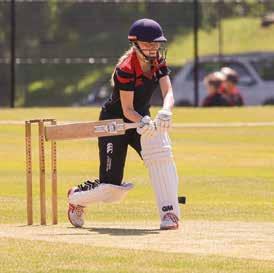

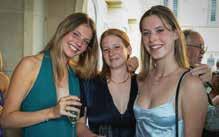

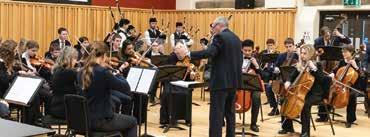

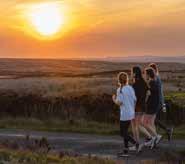



WelcomeGood that the Ampleforth College magazine is called the ‘Diary’ since diaries are the best way to treasure memories by the craft of the written word and wellchosen photos.
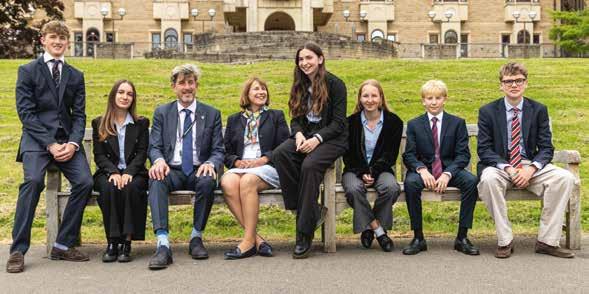
I much look forward to reading this edition, reflective of the great variety of activities and achievements in the valley across the burgeoning of spring and into the glorious summer which began as we celebrated a fine year for the school at a happy, relaxed, and sociable Exhibition.
Just to think that Marie and I have only been here for five minutes, but already we have heard Schola sing (extremely well) in St Peter’s Rome, we have been to Monte Cassino with Father Henry, avoided any paint being splattered on our Sunday togs at the Colour Run, and loved the fervent House spirit shown at all inter-house competitions, from athletics to swimming. When we drive across to join up with the Lourdes pilgrimage later this month, we will know once again that wherever we are with the Ampleforth family, there is a sense of shared life and being at home with those who feel the same. Read on and enjoy….
By Peter Roberts Head of Ampleforth College‘Only connect’ is the epigraph of EM Forster’s famous novel ‘Howards End.’ If you have read this wonderful book, or watched one of the beautiful adaptions of it for the cinema or television, you will know that its ebbs and flows are secondary to the central message that almost all the characters, whether they are from the Wilcox, Schlegel, or Bast families, struggle to understand each other and the relationships break down between them. The main character, Margaret, is interested in others, wants to reach out and engage, deepening her understanding, to reflect, ultimately showing the power of love, overcoming the barriers of class, nation and materialism that dogged Edwardian society, over a hundred years ago.
Margaret is warm and caring, she is strong and yet honest about her failings, and she is always there to help, dependable and practical. I have always felt that Margaret must have been an Amplefordian such is her discernment of the characters of others, such is her genuine interest in all those she meets and makes welcome, but also such is the warmth of her heart in supporting the foibles and waywardness of many around her.
The depth of Margaret’s character deepens and is enhanced by the beauty and inspiration of the place Margaret comes to across the course of the novel: ‘Howards End’. The house and garden of Howard’s End are more than a place of sanctuary and solace, they are the expression of a community which has the power to heal and love, to bring the other characters into harmony and to grow, based around the strength that comes of giving which Margaret ends up encapsulating.
EM Forster was clear that Howard’s End was not in itself beautiful as a place, but it was what it came to represent with the restored and healed relationships that counted. Here, as our thoughts will go out of the St Alban’s Centre to the beauties of the valley, its fields, its brooks and its trees, then we know how
our search for depth of understanding of each other and how to approach life have been gained within the most beautiful of settings, one that inspires us to look up to the divine, but also down to steward the creation we have the privilege to live within, and have the invitation to come back to over our life to come.
Hence, the theme of this year’s Exhibition which is not only to continue in our search to connect well and in depth with each other to grow our sense of community, but also to reconnect with all those aspects of the authentic Ampleforth life that the impact of the pandemic, the straightjacket of overregulation, the wider context of economic and social challenge and the war in Ukraine, have all undermined should be restored to our Benedictine way of life: our love of learning and books, our love of hospitality and welcoming people to the valley, our love of service and helping in the Diocese and neighbouring schools, and our passion for music, sport and the arts. We are on Exhibition and we welcome you to the celebration of the gifts we want to share with you.
For the Leavers, whether going on travels after the last public exam, or embarking upon a project during a gap year, or an expedition as part of your university years, you will take a part of the valley with you and the sure foundation of our life in the Abbey. You know the phrases at this point of departure:Rimbaud: “I am going to buy a horse and go forth”. De Montaigne: “you must always have your boots on and be ready to set out”. Mme Despentes “We get up and get going!”. Gide: “One of the great rules of art is never to linger”.
But the most beautiful are the words of Christ in the Gospel of St Matthew: “come and follow me”. Follow your heart formed here at Ampleforth and go with Christ, sure in your pathway, but ready for service which will be unexpected and uplifting.
Peter Roberts, Head“FOLLOW YOUR HEART FORMED HERE AT AMPLEFORTH AND GO WITH CHRIST, SURE IN YOUR PATHWAY, BUT READY FOR SERVICE WHICH WILL BE UNEXPECTED AND UPLIFTING.”
The Art Department has, as ever, had a busy and successful year. The department was soon filled with weird and wonderful monsters of all sizes as every year group started the year working on a project inspired by Dada and their Exquisite Corpse game. It was amazing to see how the Year 8s responded in collage and lino cut whilst the Year 9s made a huge collaborative mural in charcoal, with clay monsters and dry point etchings. Meanwhile, Year 10 excelled with mixed media sculptures and Surrealist oil paintings, whilst the Year 12s explored performance.
Year 11 and 13 were working hard on their coursework and enjoyed very inspiring trips to London to see Art first hand in the Tate and National Galleries.

All the Sixth Form artists entered the national public speaking competition ARTiculation, eight of whom were selected for the school finals. Josie Blake-James (M) Year 12 was chosen to represent the school at the regional finals in Newcastle, where she came second, narrowly missing a trip to London’s National Gallery for the grand final.
Year 10 all participated in the junior part of this competition, Discover ARTiculation, each producing a short film about their chosen artwork. Those selected to go forward to the regional heats were Clover Jenks (A), Minnie Wilson (M), Mollie Shaw (M), Sasha Franchetti (A) and Poppy Speir (A). As the summer term drew to a close, Year 12s enjoyed a much-needed boost to their creativity with a trip to the Yorkshire Sculpture Park, and those involved in the primary schools’ outreach week designed and led a day of fun and learning for local children.


The BTEC department has had a busy year. It started with a joint trip to the Nidderdale Show where students were given a range of investigative tasks related to their BTECs, and the Hospitality students met with one of the show organisers. In Countryside Management, the students valiantly coped with all weather conditions to successfully complete the practical elements of their course as well as meeting with and presenting to relevant countryside organisations such as Nidderdale AONB and the Howardian Hills Parks Officers. Another highlight was their visit to the Yorkshire Heart vineyard to study a Land Based Enterprise.
For Hospitality students, the high point is always the dish design and preparation for their two food units, and this year they continued to show their professionalism and creativity in the teaching kitchen. For Year 13 their work on the Environment and Sustainability unit took on added importance as it was delivered against increasingly gloomy predictions about the world’s climate. They ended the year with over half of the cohort gaining Distinction *.
In Enterprise, the students had a great day out at HECK HQ in Bedale where a frank and honest overview was delivered by Andrew Keeble on the risks and rewards of being a business owner which was fantastic. One of our students delivered a presentation which summarised his coursework on HECK, a big moment for an enterprising student! We then donned full PPE for a factory tour, before moving to the testing kitchen where the students thoroughly enjoyed tasting the variety of products on offer and gave feedback.
It’s been another busy year in the Business and Economics department. Mid-October saw an early start for our students as two buses departed at 7am to get to The Trafford Centre, Manchester. The students had a great day at the Strong Foundations Exam Conference and were able to talk to principal examiners about the A Level Business and BTEC Enterprise examinations. There was also an opportunity to attend workshops targeted at specific areas of the course.
As part of the department’s commitment to wider reading we have invested in a Business and Economics library; not only are the books tailored to the courses we teach but there are also some key texts that any Russell Group University applicant should read.
All our departments’ lessons are held in the Bamford Centre, and we embraced the opportunity to begin working again with JCB on an exciting project –more details to follow! As we come to the end of the year, we had the opportunity to visit the Heck Sausage factory in Thirsk. It was great for our students to see how the production process works along with the other functions of a business. By far the highlight of the tour was the research and development kitchen where the students were able to try out the product and test a range of potential new sausage flavours!
May always sees the Royal Society of Economics Young Economist of the Year Competition. This year the topics ranged from the development of AI to the wages of sports personalities. We have some excellent students and the calibre of the entrants this year has been very high with some different approaches to the essay questions.

The CCF has changed a lot in recent years with most changes being made as a result of post training feedback. This year, having slightly fewer cadets resulted in more personalised training opportunities. The annual cycle began in September with the Year 9 induction and selection, Year 10 Army cadets taking

on their Self-Reliance module, and the Cadre Course starting their Methods of Instruction training. There was fundraising success at the 2022 Royal British Legion Poppy Appeal which ended with a poignant ceremony around the Field of Remembrance in a show of respect for the fallen and the RAF Section conducted their Air Experience Flying programme.
As time went on and autumn turned to winter, the syllabus metamorphosised. Campcraft training turned into fieldcraft training, instructing cadets how to lead and teach changed so the students became the instructors. Planning for our Annual Inspection ramped up as did preparations for the 2023 Summer Camp to Borneo, our fourth such trip in 10 years. It was wonderful to welcome Maj Gen Chris Ghika CBE (E88), General Officer Commanding London District (and one of our two most senior serving Old Amplefordians), back to his old parade ground to inspect our Guard of Honour. There were other exciting developments too: seven cadets chose to participate in the Tandem Skydive in May, the 2022 Nepal Expedition was led entirely by CCF staff, and the National Cadet Clay Shooting Competition ended up in success with trophies returning to their ‘usual’ places in our trophy cabinet. Other changes included staff appointments in the RAF Section, CCF cadet prize winners (too many to list here) and additional course qualifications to add to the already impressive list of qualifications the staff possess. Hopefully next year will be as successful as this year was!
The Christian Theology department has had an excellent year. We had a number of Year 9 and 10 students who won prizes for the Catholic Young Writers award on their essays on the Eucharist. The Sixth Form Aquinas Society has been as popular as ever, getting together weekly to discuss philosophical and theological issues. The Newman group students have been blessed again with the knowledge and wisdom of Fr Henry Wansbrough’s lectures. We entered a team into the St Andrew’s University Ethics Cup Competition which took place at Leeds University. It was a valuable experience, and we are keen to return next year and do better.

The Classics department has had a busy academic year, with students studying Latin, Greek and Ancient History from Year 7 to A Level. In Latin, we are piloting a new text book, Suburani, which introduces the Latin language in the context of the gritty reality of daily life in the Subura district of Rome. We intend to use this course as a springboard to an exciting new Classics curriculum for Years 7 and 8, in which Latin and Classical Civilisation will be taught in tandem.
In Year 9, as last year, the students in set 1 Latin have also had the chance to have a taste of the remarkable language of Classical Greek, while seven Year 10 students are currently preparing to take Greek GCSE next year. In the Sixth Form, Ancient History is becoming an increasingly popular A Level option, alongside Latin and Greek. Several pupils have taken two Classical A Levels this year.
Ampleforth classicists have also been busy outside the classroom. In February the department ran a trip to the Bay of Naples for senior students of Classical subjects. Sixth Form students have submitted entries to national essay competitions and to the Sam Hood translation prize, run by the Classics Faculty of Cambridge University. Candidates render a Classical text into an artistic English translation, an enterprise which requires accuracy and artistry. This year, Will Shipsey (H) will be entering a translation of a fragment of Sappho, a highly complex text even at university level.
By
Duncan Bradbury, head of Computer ScienceComputer Science at Ampleforth provides our students with the opportunity to face the world with all the tools they need to be responsible digital citizens and to flourish in a rapidly changing digital landscape. It is our exceptional students who then take these tools and turn them into meaningful contributions to society in whichever field they pursue. Many of the highlights and achievements in the Computer Science department this past year demonstrate that our futures are in good hands with our computer scientists programming in four different languages from their beginnings in Year 7 to becoming the next OAs, developing an in depth understanding of the ethical impacts of digital
technologies and understanding the developments and impacts of cyber security to name but a few.
Project work in the Computer Science department serves to give our pupils the opportunity to really show how special they can be. Notable digital artifacts from this year have included a chess AI, a simulation of the ancient Chinese abstract strategy board game ‘Go’, and an accomplished network port scanning application. The talent, creativity, and ingenuity of our young people is inspiring and with the support of our senior leadership and the investment in the department over the last few years there is plenty more talent coming through.
This year the Ampleforth theatre has put on three productions. The first, an atmospheric re-telling of Mary Shelley’s Frankenstein. Set in a single location, the story explores the danger of man’s search for scientific knowledge, mixed with his desire to feed his own ego. The production used various techniques, a mix of epic and naturalistic styles were embedded.

Next came ACT Showcase, primarily organised by students who would like to show off their desired performance talents, whether that be singing, dancing, or acting. Students are encouraged to develop and show their passion.


Third was David Almond’s Skellig, this year’s Exhibition play. Skellig is the story of a young boy, Michael, who encounters a human-like creature living in the garage of the new house his family has moved into. Michael is going through an uncertain time in his life and dealing with problems ranging from family to social. He has to navigate through a world where his new baby sister is dangerously ill, and the creature in his garage is rotting away. It was an accomplished production from our Year 9 and 10 students.
In January, professional Theatre Director, Ian Nicholson, came to talk to our Upper Sixth about the world-renowned Director Katie Mitchell. We were also visited in January by Tour Manager Gordon Isaacs, who has worked with Micky Flanagan, Jason Manford, Peter Kay and Dynamo. He gave a talk on getting into the backstage industry. Sound Designer,
Peter Rice of the Association of Sound Designers also spoke about the principles and techniques of sound design and careers in the industry.
Two Design and Technology field trips took place this year. Year 10 visited Nissan’s assembly plant in Sunderland and also Labman Robotics in Stokesley – both tied in with their programmable black box project. Year 12 students visited the Design for Industry and Automotive Engineering Departments at Northumbria University before a tour of the architectural and civil engineering sights of Gateshead Riverside, The Sage, and Millennium Bridge.
Six Year 9 Design and Technology students represented Ampleforth at the Global Underwater STEM Challenge at Blyth, Newcastle, applying their knowledge of Lego robotics and working well as a team.
Lower Sixth students Ronaldo (C), Mieszko (C) and John (D), and five Year 10 students spent six months designing, building and testing rockets to take part in the regional heat of the UK Rocket Competition. Our Lower Sixth team managed to successfully get their rocket close to the target height of 850 feet, land the payload (an egg) safely in the 42-45 second window, and recover the motor section separately; they are looking forward to next year’s challenge.
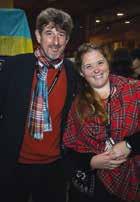
Students of English have been engaged in developing their skills of creativity, imaginative writing and independent research this year, engaging with some challenging works of literature while refining their written prose.
Year 7 students have been exploring where different cultures believe we all come from, by examining different creation myths and writing their own. Year 8 have been considering the challenges of balancing the tension between your family and your nation by reading Sophocles’ Antigone and exploring complicated questions of colonialism in The Tempest. Year 9 students have been learning about Romanticism and industrialization, inventing their own Frankenstein-inspired monsters, and trying to make sense of Macbeth’s journey to the Scottish throne. Years 10 and 11 have been perfecting their skills of descriptive writing and critical reading by examining the poetry of ageing and wisdom, First World War drama and the Australian Gothic novel.
Sixth Form Literature students have explored the literature of tragedy and crime writing attentively. Year 12 students have made an excellent start to their independent summer research projects on writers of their own choosing; and Year 13 students submitted some sophisticated independent critical essays in January, including studies of the Japanese novel, the literature of American post-abolition plantations and feminist fairytales. The Sixth Form Poetry Society has met regularly, with members sharing a mix of original writing and work by established poets. Approximately half of the department’s Year 13 students have applied to read degrees in English or closely related fields this year at Russell Group universities and are looking forward to extending their literary knowledge.

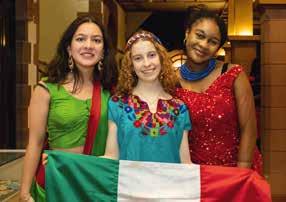 By Rita Bose, Head of EAL
By Rita Bose, Head of EAL
The EAL Department has had a very busy and successful year. Congratulations go to the 15 Sixth Form students who have taken their IELTS exam, which is a requirement for a UK university. Everyone passed, with the average score being a Band 7, which is high!
In January, a group of about 30 students from EAL and their guests celebrated the Chinese New Year together with a fabulous Chinese banquet in York. What a wonderful occasion this was, with so much laughter and new friendships formed.

During the Culture and Diversity week in March, EAL students all prepared presentations describing their own ‘Cultural Journey’. These were displayed in Main Hall throughout the week as the students represented their own country, with their flag and items unique to their country, such as Lederhosen from Germany! We were all able to sample and enjoy the rich diversity of food from a variety of countries.
Our students have also all engaged well in our Cultural Programme, with discussions on the Coronation, the Royal family, the countries and traditions of the UK, the history of York and the Great British Seaside. This will culminate in an EAL trip to Whitby before the end of term.


Michael Palin famously said of Geography, that you can travel the seas, poles and deserts and see nothing. To really understand the world, you need to learn about geography. This term, our Ampleforth Geographers have been doing just that, and in recognition that you don’t always need to travel too far to adventure outside of your own bubble, they have stayed close to home. The Year 10 Geographers travelled to Cumbria where they stayed overnight in Keswick to investigate changes in a rural settlement and downstream changes in a local river. The Year 11 Geographers also ventured to Cumbria, where they visited Morecombe Bay to investigate the sea defences there and spent a day in Barrow-in-Furness researching quality of life. The Year 12 Geographers spent three days in Scarborough, learning about how to conduct a geographical investigation as part of their A Level. The
A Level students also spent a day at the University of Huddersfield doing practical fieldwork where they used a wave tank to look at how human interference of the coast affects physical processes.

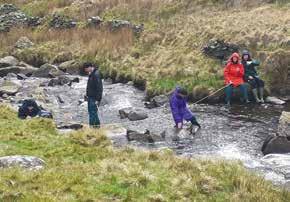
As always, the Ampleforth Geographers have been thoroughly delightful in their approach to each challenge they have faced, be it desperately trying to convince local residents in a torrential downpour to answer their questionnaire; or measuring the width of a Cumbrian stream whilst the thick rain clouds obscured everything but the surrounding sheep. They have been good humoured as they seek the big picture and try to gain a greater understanding of their world.
The History Department has had another busy and vibrant year. Our focus, as always, has been to teach our courses in as stimulating and effective way as possible, with Year 7s learning about British and world history from Henry VIII to George III, Year 8s learning about British and world history from the American, French and Industrial Revolutions through to the start of the twentieth century, and Year 9s learning in depth about the First World War, Suffragettes, Russian Revolution and Stalin. Year 10s and 11s have studied Nazi Germany, the Cold War, Inter-War America and the Middle East in the twentieth century, and the Sixth Form have studied Stuart and Cromwellian Britain and nineteenth century French and German history.
Particular highlights have been Year 9 projects on topics as diverse as the Spanish Armada, Napoleon Bonaparte and the Holocaust, Year 13 research essays on the English Civil War and a range of topics on Nazi Germany and, perhaps most of all, the undergraduate level lecture given to our Sixth Form historians by Professor Richard Rex of Queens’ College, Cambridge, on Religion and the Causes of the English Civil War.
The History Department also again ran its annual national history essay competition for prep schools which this year attracted over 120 entries that covered a huge range of topics. They included the First World War, the Suffragettes, the Battle of Britain, Pearl Harbor, the Cold War, women composers, Samurai warriors, the Falklands War, Lady Jane Grey, Nicolas Winton, Nelson Mandela, the Indian Mutiny, the Anglo-Boer War, the Mona Lisa, Alaska’s purchase, animals in WWII and many, many more. The History Department is proud to encourage such interest in history both within the school and nationally.
In Mathematics, Ampleforth students have participated in a variety of national challenges. In the UK Mathematics Trust Senior Challenge one student got a gold award, and three achieved silver awards. Furthermore, Ao Liu (C) Year 13 went on to gain a distinction in the British Mathematical Olympiad. In the intermediate Challenge, one student gained gold and four others were awarded a silver award. In the Junior Mathematics Challenge, Cullen Lyness (EW) Year 8 obtained a gold award and qualified strongly for the second round, with two others gaining silver awards. We also had two teams of four from Year 10 take part in the York Maths Feast at York St John University. Both teams distinguished themselves, with one of our teams receiving a certificate for highest score in round 2 and the other team for the highest score in both rounds 2 and 3!

The Modern Foreign Languages’ Department continued to flourish this year. There was a grand total of 42 A level entries – a rarity in the national picture. There is a thriving on-timetable and offtimetable offer, including lively speaking classes. The students were fully engaged in thoughtprovoking and academically rigorous independent research projects. These included subjects as wide-ranging as: ‘Are Austrian hunters being cruel?’ (Louis), ‘Are Grimms’ fairy tales still relevant
today?’ (Josephine), ‘Why is secularism such a challenge for the French Republic?’ (Ruby), ‘To what extent does the legacy of Yves Saint Laurent go beyond French fashion?’ (Keza), ‘Franco’s impact on sport’ (Dimitri) and ‘To what extent was Eva Peron a positive influence in Argentine politics and society?’ (Daisy).
The Linguistics Society was attended not only by students learning foreign languages but also by some computer science and mathematics students. They all shared an interest in exploring language as a code, as an ensemble of data which requires intelligent and logical deductions. In February 10 academically courageous students including Year 10, 11, 12 and 13 put themselves forward for the Linguistics’ Olympiad. For 2.5 hours these students completed five highly challenging tasks which this year included the languages Albanian, Lardil, Meroitic, K’iche’ and Filomeno Mata Totonac. They thoroughly enjoyed the challenge and, when the results were published, we were very proud of Ruby (M), who received a Bronze Standard certificate placing her in the top 20% nationally. Ruby later received the MFL prize at Exhibition not only for her academic excellence in French, but also for her bronze award in the very academically challenging Linguistics Olympiad.
One of the big highlights of the year for the MFL Department was the cultural diversity week. Promoting cultural diversity is something that the MFL department does on a regular basis, but the week was a great opportunity to have all the students learning a language engaged in this as a common goal. The younger students had fun creating and putting up posters and flags, playing Chinese ping-pong balls with chopsticks or writing Chinese calligraphy; older students analysed songs or poems where respect for diversity and difference was the key theme. Some recited with the solemnity required the anti-war poem ‘Distinto’ (different), by Nobel Prize poet Juan Ramón Jiménez, exiled from Spain when political diversity descended into outright civil war. Others enjoyed the reading of ‘Déjeuner du matin’ by Jacques Prévert and discussing what makes it so quintessentially French. In all MFL lessons the students learnt about attractions, achievements, great figures (past and present), and even quirks such as the fact that the national anthem of Liechtenstein has the same tune as our own!
It has been a year full of milestones in the Music department. Now there is greater confidence in foreign travel it was wonderful to rekindle the Schola tour schedule and what better place to do this than Rome. A week of liturgical performance over Palm Sunday and Holy Week and an incredible experience both musically and spiritually. We also gave our first performance of Messiah in three years. The Abbey was packed and the combined forces of the Schola Cantorum and the Ampleforth and Ryedale Concert Choir were given a standing ovation for their outstanding performance. It is both wonderful and a huge relief to get this magnificent work back in the annual cycle of concerts.
Within our orchestral concerts we had performances of the Haydn Trumpet Concerto and a Chopin Piano Concerto from Grace Walker (B) Year 13 and Adrian Kong (H) Year 13. Both excellent and accomplished performances which not only demonstrated their musicianship but also marked the end of their brilliant musical careers at the College. Outside of the regular concerts we were delighted to welcome world-renowned Baritone Marcus Farnsworth to lead vocal and choral workshops, as well as giving an Evening recital.
Just before the Easter holiday we held the first House Singing Competition after several years of silence. Over the preceding two terms each House presented a lunchtime recital including a full House song in readiness for the competition. It was brilliant to see the enthusiasm and friendly rivalry forming over these months. Even more wonderful were the occasions on which we met and heard new musicians amongst the students.
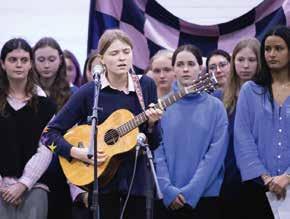
This year also saw the commissioning and premiere of a new motet for the Schola. Ampleforth Jubilate was composed by world renowned Organist and Composer, David Briggs. The piece was commissioned by the College to mark the retirement of Mr William Dore after nearly 30 years on the teaching staff. Its first performance was given at the Exhibition Mass. It was, I hope, a fitting way to mark a distinguished career of an outstanding musician and show deep appreciation for all that he has given to Ampleforth.

The Politics Department had excellent year. As well as having its largest ever cohort, making it the most popular A Level in the school, the results for 2021-22 were very pleasing. There was a very healthy number of As and A*s and our value added (the measure by which the impact of teaching is clear) was favourable amongst students with Special Educational Needs, reflecting deliberate strategic work in that area.
Much of this success was thanks to James Rainer, who left the Department and Ampleforth College at Easter. He was instrumental in revamping our resources for the teaching of the Political Ideas module in particular and made a very positive contribution to the students’ academic work. We are grateful to have been able to appoint David Strange to replace him, who has already proved himself a worthy successor.
The Politics Department prides itself not just on preparing students for success in exams, but also in development of values-driven citizens and future leaders. Students were enriched by a wide range of guest speakers, including Tom Newton-Dunn, Sir Geoffrey Adams, Sir Anthony Seldon, and our own MP Kevin Hollinrake.
A high proportion of our students go on to study Politics at university, and this has continued to be a trend – a reassuring indication of the impact of the subject on the academic lives of our students.
It has been another busy and productive year in the Bamford Centre and beyond. We have seen great success in academic competitions across the three Sciences. In the Society of Biology Olympiad – Sophie (A) came away with a much sought after Gold Medal. Honourable mentions to Akshay (C) and Grace (B) with Silver medals. In the Royal Society of Chemistry Olympiad, Akshay came away with Gold, and Grace, Kimi (B), and Josephine (B) got Silver medals. Our Chemists also saw success in the Cambridge Chemistry Challenge Award Winners with Akshay, Kimi, Sophie and Arthur (T)
all gaining Silver medals. In the Physics Olympiad, Arthur, Kimi, and Reuben (J) were medal winners. We warmly congratulate these successful Year 13 Scientists – these are some of the most challenging competitions around. Our Year 12 scientists have recently taken part in the Society of Biology Intermediate Olympiad and in the Royal Society of Chemistry analytical competition – we await their results with baited breath!
In October our Year 13 Biologists visited the Blencathra Field Studies Council Field Centre in Cumbria and, despite variable weather, made excellent progress with the ecology side of their A Level studies. Some torrential downpours did nothing to stop some excellent work in the field. Our Sixth Form Physicists visited York University Department of Physics in March and enjoyed a variety of activities including advanced astrophysicists. They were certainly challenged and taken well outside the comfort zone of their A level Physics specification. In April many of our A level Physicists and Biologists attended an online Royal Society Lecture looking into advanced methods for Cancer detection. Dr Guy Sutton visited our Sixth Form Biologists twice this year presenting all day seminars on advanced neuroscience, forensic science and the molecular basis of disease. He is always a highlight of the A Level Biology teaching year and once more amazed and stretched our students in equal measure! In February, our Year 11 Scientists visited Sheffield for a day of GCSE Science Live lectures –memorable talks from Robert Winston, Simon Singh and Hannah Critchlow stretched and challenged even our most able GCSE Scientists.
The Science department continues to offer outreach activities – memorable Prep school science days have switched on many prep school students to the wonders and delights of Science with practical activities led by Mr Howard demonstrating the breadth of chemical reactions on Earth, Mr Townend showing students the science of light and Mr Anderson leading students through the use of DNA
in crime scene analysis. We continue to offer practical activities on school open days – the highlight of many a visiting student’s day!
Ruby:
I have had the pleasure of being Sports Monitor this year, and I am very proud of the variety and inclusivity we enjoy in our sport. Everyone is able to participate in whatever they choose, and advance, not only in their sporting ability, but also in their knowledge of significant Ampleforth values, such as community and perseverance.

Hockey: Coached by Mr Metcalfe, the 1st XI girls reached the Tier 4 U18 North of England Finals, narrowly losing on penalty shuffles. The U15A girls won 10 out of 11 of their matches! I enjoyed the Performance Hockey Tour to the Netherlands in February for Year 10-13 girls, where we received a professional training session at Rotterdam Hockey Club and played two exciting matches. The boys’ 1st XI team reached the 4th Round of the National Cup Competition, and the U13A team won 9 out of 13 of their matches. Everyone appreciated the tense OA mixed match, which received quite the crowd.
Tennis: Mr Metcalfe and Mr Orton triumphed in the tennis. The 1st boys’ team progressed to the 3rd round of the LTA National Cup match, losing to a very strong Bradford Grammar side. The U15A girls’ team celebrated only losing one match, whilst the U14 girls had an unbeaten season!
Golf: Mr Harrison, a 2.6 handicap golfer, entered Ampleforth in multiple matches, including the OAs at Ganton, and against Sedbergh, Pocklington and a triangular with Stonyhurst and Giggleswick. Also, with the club being mostly made up of Year 13s, we are
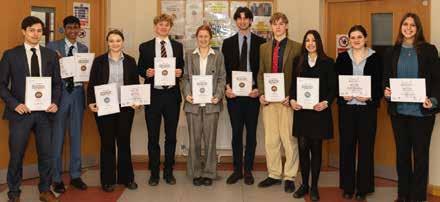
keen to invite new golfers to join next year to maintain the high standard.
Basketball: Basketball progressed greatly this year. Not only is it a well-attended activity, we have engaged in numerous inter-school matches, and even introduced basketball as a House event.
Netball: Headed by Nia Jones, the Leeds Rhinos Superleague Captain, Ampleforth has hosted numerous Tournaments, such as the Years 5 and 6, and Years 7 and 8 Netball Outreach Tournament, and the U18 Tournament, all of which will be hosted annually. The 1st and 2nd teams entered the Queen Margaret’s Tournament. A number of girls have gone on to play at higher levels: Stephanie Okojie (B) Year 10 played in the U15 North Yorkshire Netball team this season, and Melisa Anyim (B) Year 12 performed in the U17 and then the U18 Leeds Rhinos Netball Performance Development Pathway, congratulations to them!

Cross country: Dr Anglim has been running the cross country this year (no pun intended). Whether exploring through the valley woods on a 10km, or enduring ‘100 sit ups Wednesday’, it has certainly been enjoyable. Students enjoyed orienteering and the 5km park run events. We even saw the return of the OA fixture, after it was cancelled due to Covid. I personally enjoyed representing North Yorkshire, the English schools Cross Country Champs in Wollaton Park, alongside Cicely JohnsonFerguson (M) Year 13. Students also had an insightful talk from Imo Boddy, the youngest female to run the length of Britain, and OA Chris Copping (J76).
Luke:
This year I have had the opportunity of being Sports Monitor and I am very proud of the sport at Ampleforth and the way it is played with passion, sportsmanship, and pride. Over each term it has been clear to see the commitment from all students regarding their sports and this is reflected in the recognitions they have received from their hard work.
Football: Winning away at St Peter’s is always an

achievement, and perhaps Hippolyte Franchi’s outrageous scorpion kick goal in a 1st v 2nd XI exhibition match was the highlight of the year!
Cricket: Following the very enjoyable Under 14 and Under 15 sports tour of Sri Lanka over Easter, much was expected of the cricket teams. The girls’ U15A side were crowned Yorkshire Indoor Champions, coming third in the North of England Finals and winning the St Peter’s Festival. Six girls’ squads played and the standard across the teams has been impressive. The boys’ 1st XI could not quite match the success of last year’s record-breaking side, but much is expected of the current Colts teams who had many excellent individual performances. The junior sides played numerous games with many of them stepping up to older age group cricket.
Swimming: Ampleforth swimming covers the autumn and spring terms however, the competitive season is between January and March. This period always starts with the Inter-House gala. Following the success of the internal galas, the focus was switched to InterSchool matches. There was no denying the incredible levels of effort put into the team performances against other schools throughout the year.

Ultimately it has been a successful year and I look forward to the continued success of the sports programme at Ampleforth and what the future holds.
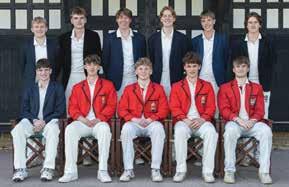

The young women of St Aidan’s continue to be a daily inspiration, be it in juggling the routines of a busy boarding life or developing their individual talents. Each makes their own unique contribution to a thriving and diverse community. As a flavour, this year has seen a Karate Black Belt grading, diploma level piano recitals, competing at Hickstead, and a Gold Medal in the national Biology Olympiad. Just as important though, are the countless small personal achievements and triumphs of the girls in an environment of collective encouragement and celebration. Whether having the courage to take part in a new activity for the first time, or showing up when the going is tough, these are the tiny wins that help to build a close-knit and supportive community.
It is a gift to live alongside 60 wonderful and unique students and to share in their experiences throughout their years at the College. There is certainly never a dull moment; they teach us and each other a great deal about what it means to be part of something bigger than ourselves. Among the many prizes awarded at Exhibition, we were proud to have among our ranks the recipient of the ‘McAndrew Shield’ for the second consecutive year. Awarded for having a consistent positive influence in the school and demonstrating behaviour that accords with our Benedictine core values; this is one to cherish.
Our outgoing Year 13s illustrate the resilience and spirit of the House, a year group that has lived through the disruption and uncertainty of the pandemic, some of them living under three different Housemistresses during their time here. The House
spirit and ethos first and foremost come from the girls. Their embodiment of our shared values is an inspiration, both as we accompany them during their time here and as we say farewell. We hope that they will always feel a deep connection with St Aidan’s.
We have worked to improve the garden space this summer, with the simple addition of a tree bench in the centre of the lawn subtly transforming how the garden is used. Work has begun on our ‘Aidan’s Allotment’ and we look forward to providing an update on that next year.
This summer we say goodbye to Louise Frith-Powell as Assistant Housemistress. She has been a fantastic part of the House Team and fundamental in the support and development of the House ethos. We have been blessed to have her with us over the past two years and wish her the best in her new en-deavour as she launches her own art school in the Lake District. Stepping into the role is Clare Moses and we are thrilled that we will benefit from her experience and enthusiasm moving forward.
Ably supported by our newly-appointed monitor team, planning is already underway for the coming year, with a focus on developing the House chaplaincy and also encouraging the girls to make bold steps in becoming active participants in shaping issues of importance to them.
St Bede’s House has been blessed this year with an incredible cohort of amazing young women
and a devoted House team. The resplendent and overwhelming atmosphere in the House has been one of joy, confidence and celebration. We began our transformative experience as we navigated our way through the rising tide at Holy Island during our House Retreat in October and laughed about it afterwards in the home of Ida Bridgeman, one of our supportive Old Girls. Whilst her mother provided us with eight pairs of dry trousers and several t-shirts and jumpers, her father made us feel welcome over hot chocolate and rocky roads. We encountered many challenges in the Spring term against the formidable St Margaret’s and St Aidan’s who had been trail blazers in many respects. We were not found wanting and rose to the challenge. In sport, we were blessed with many trophies, most notably House Athletics, House Swimming, House Cricket, House Basketball, House Squash, House Badminton, Senior Ampleforth Mile, Golf and Shooting among others. Our girls mesmerised audiences in the dance and drama showcase as well as in the school plays. We boast the presence of incredibly gifted musicians in St Bede’s –Grace Walker, Kimi Middleton and most notably, Lucy Barratt, from National Youth Orchestra. We must not forget Emma her sister who is an outstanding young pianist in our Year 9. We have celebrated our new Monitor team this term who are all academic scholars in their own right. We have built a strong sense of community this year with the help and support of our tutors, our Old Girls and our families.
It has been an eventful and enjoyable final year for St Cuthbert’s as a stand-alone boarding house. While


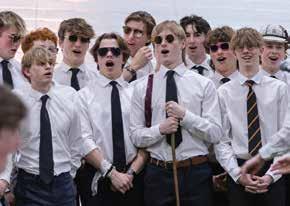
much change has occurred, and will continue to, the high levels of achievement and strength of character among the boys has remained a constant. The House has been blessed with an Upper Sixth brimming with Amplefordian values and house spirit. The leadership of Jack F (Head of House) and Patrick S (Deputy Head of House), as well as the School Monitors Frank C (Deputy Head of School), Luke T (School Sports Monitor), Victor Gallwey (Chaplaincy Monitor) and the wider year group has been nothing short of outstanding. They will inevitably be successful in their lives beyond the College.
The House enjoyed much success on the sporting front, with highlights such as winning Inter-House Tennis and Golf in the Summer Term. We have had much to celebrate on an individual level too: Iggy A showed immense stamina and perseverance to win both the Senior House Cross Country and Ampleforth Mile races; Mieszko D triumphed in the Senior Javelin, Long Jump and Discus Throw in Inter-House Athletics; Patrick S, as fly-half for the 1stXV, 1stTeam Hockey player and Captain of Cricket, was unquestionably the deserving winner of the Sportsman of the Year Cup at Exhibition; Rollo S has represented Yorkshire U15 Cricket team and scored his maiden hundred for the U15 College team. Miles T qualified for the Equestrian National Championships for Dressage... The list goes on. However, what is most pleasing is not the winning, but the unwavering commitment of all of the boys to House Sport and competitions and the pride they take in representing St Cuthbert’s and the College with distinction.
Exhibition Prize Giving also saw the recognition of many fine achievements in the academic, musical and
extra-curricular endeavours of the boys this year. Daniyal A was awarded the Cragg-James Prize in Year 9 and Benedict A-B the Stourton Cup, a new award for the top Year 10 RAF cadet. The strong house presence in, and dedication to, the CCF was also exemplified by Sam T receiving The Silver Platter for embodying the values of the CCF as an outstanding cadet and Ronaldo C receiving The Forbes/Stacpoole Bowl for enterprise and endeavour as a leader in the RAF section. On top of these, many more boys in the House received awards from academic departments for their hard work and achievements.
We have celebrated more than just awards. During the year we have joined together for a baptism and five boys’ confirmation into the Roman Catholic Church, as well as two boys’ confirmation into the Anglican Church. The spiritual core of the house is alive and well.
As to where I have come in, at the end of the Lent term the House said farewell to Housemaster James Rainer after eight years of dedicated service to the care and formation of the boys in his charge. Under his leadership, the now firmly embedded ethos of kindness and friendship in the boarding house has grown and flourished. His positive impact on the lives and moral character of the boys was, and remains, immense. They put their heads together and gave him a wonderful and moving send-off at the House Punch before Easter, showing their full appreciation for all he had done for them and those before.
The House has also said fond farewells to Assistant Housemaster Justin Metcalfe and Chaplain Fr Richard both of whom have given themselves and their range of gifts and experience to the betterment of the House. We thank them both for all they’ve done.
In September, St Cuthbert’s merges with St Thomas’ House. An exciting development that strengthens the College and the boarding experience of the boys immeasurably. I’m certain they will continue to thrive under Housemaster Simon Rudsdale, supported by our long-standing and much loved matron Sally Milestone.

Despite all the change, the spirit of optimism, friendship and family has shone through. In a unique year, perhaps more than ever, St Cuthbert’s House has a huge amount to be proud of.
This year has seen a year of change in St Dunstan’s & St Oswald’s. With the support and leadership of Head of House, Tom, Assistant Head of House, Felix, and the inaugural House Council, many new initiatives and improvements were introduced to the House over the course of the year.

At the heart of these new initiatives is the strengthening of Student Voice. By installing democratic structures into the House, we have ensured that every student can have a say in the running of the House and is part of the decisionmaking processes; thus, the members of the House community take ownership and control over the direction of the House.
The tuck shop, which is run as a student enterprise, ensures that all profits go back into the House helping us to improve the facilities: new sofas, a drum kit, pool table lights, disco lights, a smoke machine, the repair of the old grand piano and grandfather clock, are just a few of the improvements we have seen.
One of the challenges this year has been the question of House identity, as the House still consisted of boys from either St Dunstan’s or St Oswald’s living under one roof. Over the first three months, we discussed this issue in the House Council and voted to keep the current name of the House. We also created a new crest by combining the two existing House crests, and designed House ties, cufflinks, et al. to match. Our new House motto ‘Plus est en vous’ reflects our attitude to always strive to do better and never settle for the status quo, as there is always more in each one of us.
St Dunstan’s & St Oswald’s is a very diverse House in terms of nationalities and talents. We have outstanding musicians including six boys in the Schola, many talented artists, serious academics, and amazing sports personalities. This year we have been proud to win 50% of all inter-House tournaments, not to mention our crack shots who won all bar one of the shooting competitions!
We are now looking to build on these achievements in the coming year under the leadership of our newly elected Head of House Charlie, Assistant Head of House Ben, and School Monitors Cosimo (Sports) and Hector (EW’s).
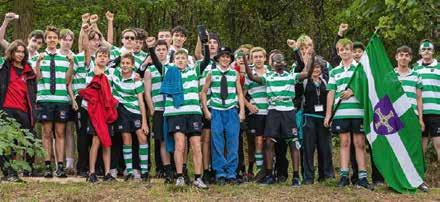
Valete: We say farewell to Dr Moses and Mr Anderson who, after many years of dedicated work as tutors, are moving on to new pastures. Finally, we wish Fr Henry the very best for his retirement after a lifetime of faithful service to the school as Housemaster, Chaplain and influential spiritual guide. We are truly indebted to you all, and you will be sorely missed.
St Hugh’s House had a lot to be proud of this year. With the appointment of four School Monitors, the House had a lot of role models to look to: Head Monitor, Charlie Mitchell, Head of House, Freddie Anders, Deputy Head of House, James Bridel, and Felix Depkat, Monitor to St Edward’s and St Wilfrid’s. The boys of St Hugh’s learnt a lot about good leadership from them and they have given the in-coming leadership team – Patrick Adams, Head of House, Will Shipsey, Deputy Head of House, Elijah Hennigan, Monitor to St Edward’s and St Wilfrid’s, and Finn McCarthy as the College’s Deputy Head Monitor – plenty to consider in their new positions.
The House welcomed 11 new starters this year, with boys joining us from the European continent and a little closer to home. Each of the boys has brought a uniqueness to the community which we all benefit from.
Many in St Hugh’s House have achieved academically and it was great to witness their efforts rewarded at the Prize Giving ceremony. From Drama to Computer Science, Politics and History to Cookery, the boys from St Hugh’s showed their prowess as a House for earnest and hard-working all-rounders. Adrian Kong, one of the Elwes Prize recipients is a prime example of this. The House and individuals within it also tasted success in Sport, CCF and Activities. Hennigan won the Nulli Secundus Cup for 2023/2024, Josh Archibald, the Michaelman Cup, and Max Murray, the Corps of Drums Award. House spirit was strong at all the House events, but we particularly enjoyed tasting success in Squash, Tennis, Cricket and Shooting.
Our House Retreat was a highlight for many. It was themed “Monk for a Day” and the boys experienced what it was like to dedicate oneself fully to a community and life of prayer, reflection and
service. Our House Chaplain, Fr Ambrose Henley, has been a wonderful spiritual guide to us all and we thank him sincerely for his passion and commitment to the House. The House is truly blessed to have such dedicated staff: Matron Dawn Butler, Housekeepers Maureen Nelson and Terry Martley, and all the tutors: Mike Slingsby, Duncan Bradbury, Hugh Ainscough, Andrew Hutchinson, Ralph Pallister, Hannah Pomroy and Sam Rea-Knowles. Mr Bradbury and Mr Hutchinson were new to the House this year and gave a huge amount of service and dedication to all the boys. Thank you.
There are 14 St Hugh’s House students who have graduated from the College this year and we wish them well in their future endeavours. They are an incredibly tight group and a talented one too. We hope they stay connected to Ampleforth.
This was another successful year in St John’s. Experience shows that good boarding houses are a blend of the formal and the informal, and this has certainly been the case in our House this year, whilst maintaining a ‘family home’ feel to life in St John’s.

We welcomed Miss Atkins as the new Assistant Housemistress in September who has been a hit amongst the boys. We are grateful for the time she gives so willingly and for her experience (it is something of a reassurance to me as Housemaster to have a trained paediatric nurse in the team!) The boys have also loved having Tilly – Miss Atkins’ cocker spaniel – a part of the House.
One theme of the year in St John’s was the development of a more positive academic culture. We mandated that Year 9 and Year 10 did prep under the supervision of a tutor in a nearby classroom, ensuring that students could easily access support and could stay on track. On Wednesday nights, we pioneered a House reading club for the Year 9 boys, which increasingly became popular with the Year 12 as well. The boys have applied themselves to their studies well.
As I often write to parents, it is my mission for St John’s boys to be effective ‘joiner-inners’ and they have met this challenge on all levels this year. We
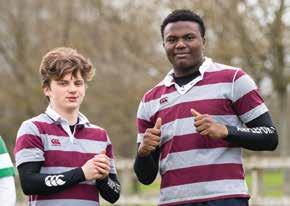
have outstanding representation in the school sports teams; our musicians are key members of the Schola and Pipe Band; there were St John’s boys as the lead roles in the school theatrical productions; and the charitable works of the school – including the Nepal Expedition, The Big Walk, and the Lourdes Pilgrimage – also have St John’s boys at their heart.
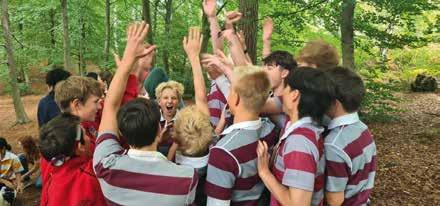
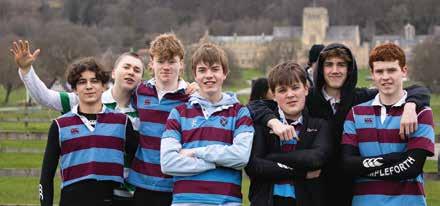
Our House Chaplaincy life has been enriched this year, not least by the introduction of new prayer books that were edited by Fr Cedd and made possible thanks to a generous donation. Our House Retreat focused on the example of Jimmy Lai – a prisoner of conscience for whom we continue to pray – and his example of righteousness in the face of persecution.
House spirit in St John’s is as good as it has ever been, and as we look forward to welcoming new boys in September, we have the benefit of excellent student leaders: George and Seb will surely build on the work of Reuben and Felix as Head and Deputy Head of House. Seamus has been appointed to be Head of School, a remarkable achievement, and is the first member of St John’s to hold the position for 15 years.
Another joyful year for the St Margaret’s girls. We were sad to see the departure of our Year 13 girls. A big thank you to Keza our Head of House for outstanding leadership and our House Deputies Cicely and Pippa. Seniors becoming school monitors next year are Josie as Head School Monitor, Lara as Head of House, Daisy and Florence as Deputy Heads of House, Evie
as Chaplaincy monitor, and Amadea as St Edward’s and Wilfrid’s monitor – six school monitors in total shows the standard of the senior girls.
St Margaret’s girls held their titles in House competitions with the Hockey, Netball, Swimming, Tennis, and House cross country to name but a few. At the time of writing, we have yet to win House Athletics but I’m sure this will happen!

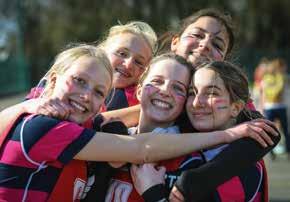
Spiritual life in the House goes from strength to strength. We have been fortunate to have the guidance of Fr Kentigern leading us in House retreats, deaneries and even those who have come to the faith whilst in the House. He’s not a bad volleyball player either – the summer game of choice for the House! Next year we are fortunate to welcome Fr Oswald to the House who will be accompanying us.
Part of charity focus this year was to raise money for Shelter, to which the girls and parents gave so generously. Some really amazing donations and offers from parents showing the strength of the St Margaret’s community raising over £2,000 for this worthwhile charity at Christmas time.
“Work must be founded on a culture of encounter…which encourages people to seek the common good.” Pope Francis said this recently to entrepreneurs at a business council. In St Margaret’s we are guided by this ‘culture of encounter’. Our girls make small daily sacrifices for each other and continue to try to be kind either explicitly or implicitly. We are so proud of the impact they have had throughout the College this year and every year.
This year has been one of development and change for St Thomas’ House. As well as the usual new starters, we welcomed a new tutor in Mr Stone and Assistant Houseparent Miss Duree, not to mention a new Housemaster in Mr Rudsdale. There were a number of ever presents though, and whilst the changes were positive, some familiarity was evident too.
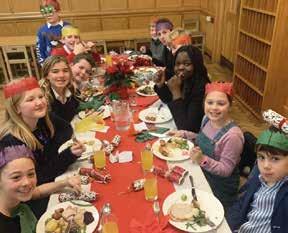
A focus for the year was that of family. We worked hard to create a homely atmosphere where boys can thrive. This was evident in the everyday exchanges between the boys, the commitment to House events and the increased success enjoyed as a family group. The community of St Thomas’ House is a special one and the year celebrated that.
Highlights of the year include a Beer Tasting evening with Dr Moses – the number of boys who liked stout was a surprise! House retreat was a huge success, dropping into the valley bottom to see Rievaulx Abbey rising in the distance was a welcome and heart-warming sight; the blessing from Fr Alexander at the altar another highlight. Christmas Dinner, with secret Santa, was an evening of laughter and real happiness. House Punch was a roaring success, with the largest cheer of the night for the announcement that the House would welcome a puppy, Star, into the community after half term!
House events may have started a little shakily, but a timely win in House Badminton reminded us we had opportunity throughout the year. Commitment
Head of House, Freddie Goor reflects on the past year in the House:
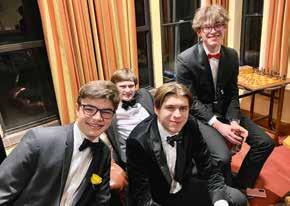
from lots of the boys was the most positive part of this, whether that be boys playing House rugby or swimming when they are not doing their usual sports, through to the grit and determination on faces as they gave their all. One of the biggest events of the year was House singing, one of the few events where boys and girls houses take each other on. It was an outstanding win for the boys and thoroughly deserved. Mr Seymour can now be seen sporting a St Thomas’ tie on a frequent basis! Perhaps the biggest win of all, however, was at Sports Day where a domination display from the juniors and a determined display from the seniors saw the House as overall winners, a fitting way to end the year.
Exhibition was another wonderful event and never ceases to impress. The family atmosphere stretched out to include parents and extended families. Sitting in the sunshine chatting to everyone was a perfect way to enjoy some of the outstanding things that the school, and boys from the House, have achieved this year.
The end of the academic year does not spell the end of the opportunities for our boys though, and we have a number of our soon-to-be top year going on pilgrimage to Lourdes. Elliott will also enjoy an exchange to Australia, undoubtedly life affirming events.
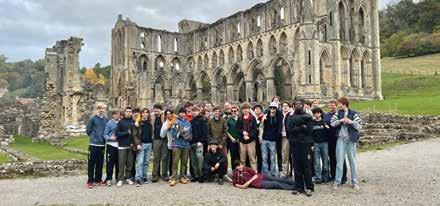
As we finish every day in House, with prayers of thanks for the opportunities we have had throughout the day, so we end the year with a genuine gratitude for all that has been this year, coupled with a renewed energy to grasp even more opportunities next year!
Lent and summer term at Junior House has been jam-packed with activities, academic enrichment and new experiences. Our students have been resourceful, independent and courageous, whilst having plenty of fun.


They enjoyed taking part in the annual Colour Run and the Swimming Gala. The House Music Recital and House Sing were impressive. All threw themselves into tennis and athletics alongside cricket with outstanding results both home and away. Javier and Alvaro performed brilliantly in the House Golf Competition as did Hector in the House Shooting Competition. Results from the Junior Maths Challenge and the Junior History Challenge were pleasing with Inigo, Tivi, Edward and Ben all taking away awards.

The House Coronation Picnic was a huge success, the atmosphere of a summer garden party with BBQ and sharing picnics and the added delight of Mr Phillips volunteering for the wet sponge fun! A similar atmosphere was enjoyed at Exhibition as Junior House parents watched on from the Bounds as Harrison, Ivan and Finn did themselves and the House proud in the Ampleforth Highlanders performance.
The year started with pre-season sports camps at the College which was hockey for the girls and rugby for the boys that led onto a successful season, winning most of the games they played. The girls had a great season of hockey with everyone being encouraged to have a go at the game, whatever their skill level.
With the start of term on 5 September, the new students in St Edward’s & St Wilfrid’s started settling in with the first couple of days being used so that they could learn what a life is like in St Edward’s and St Wilfrid’s and around the College. We had our House punch relatively early on 13 October which started with Mass in the Abbey crypt led by Fr John, followed by an amazing dinner in the upper refectory accompanied by the Heads of School and the House staff. The Christmas party followed later in December which was incredibly fun for the whole House. At the end of term also came the sport dinners for respective sports teams, there was a Hog roast for dinner and speeches from the sports coaches.
The spring term was next with a nearly unbeaten hockey season for the boys and a fabulous netball season for the girls. The junior cross-country was next where all were involved. Following on



from that was the cross-country fixture at Terrington where the top 10 boys and top five girls represented the school in the race. For the boys, there were three rugby sevens tournaments, one at Ampleforth and another one at Terrington where the team qualified to go to the next round at Bradford Grammar school where they came 3rd in their group. Towards the end of the term there was a mixed junior hockey tournament where everyone was welcome to play; it was a fun afternoon to play hockey with the different teams and was enjoyed by all! With the finale of the season it was time for the sport dinners – the boys’ hockey dinner was at the end of term and the girls’ netball dinner was held at the beginning of the summer term.
The summer term’s sport was cricket for all – the teams were made up of young and older experienced players and even though some had never played, everyone enjoyed the sport. The seasons were successful for all the teams and the coaches! The end of year exams finally came around to everyone’s delight but after a week of exams everyone is ready for the final week of term which is Enrichment Week with plenty of fun and interesting activities as the Year 8s prepare to move up to the senior school and the Year 7s start taking on leadership roles to look after the new Year 7s in St Edward’s and St Wilfrid’s.



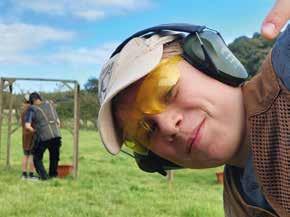
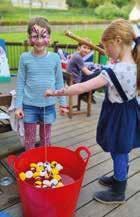
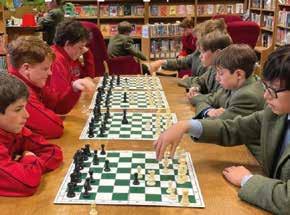


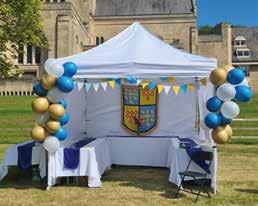
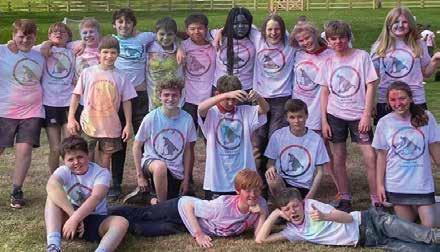

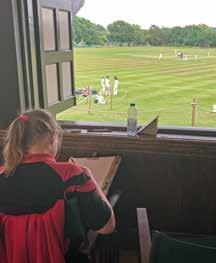

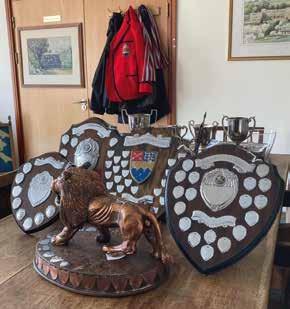 By Sebastian Phillips, Housemaster, St Edward’s & St Wilfrid’s House
By Sebastian Phillips, Housemaster, St Edward’s & St Wilfrid’s House
The Junior Prize Giving and Sports Day took place on the last day of the summer term, the finale to a very busy Enrichment Week of different activities each day for our Year 7 and 8s.

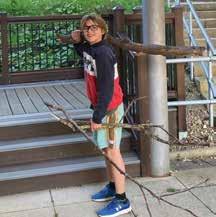


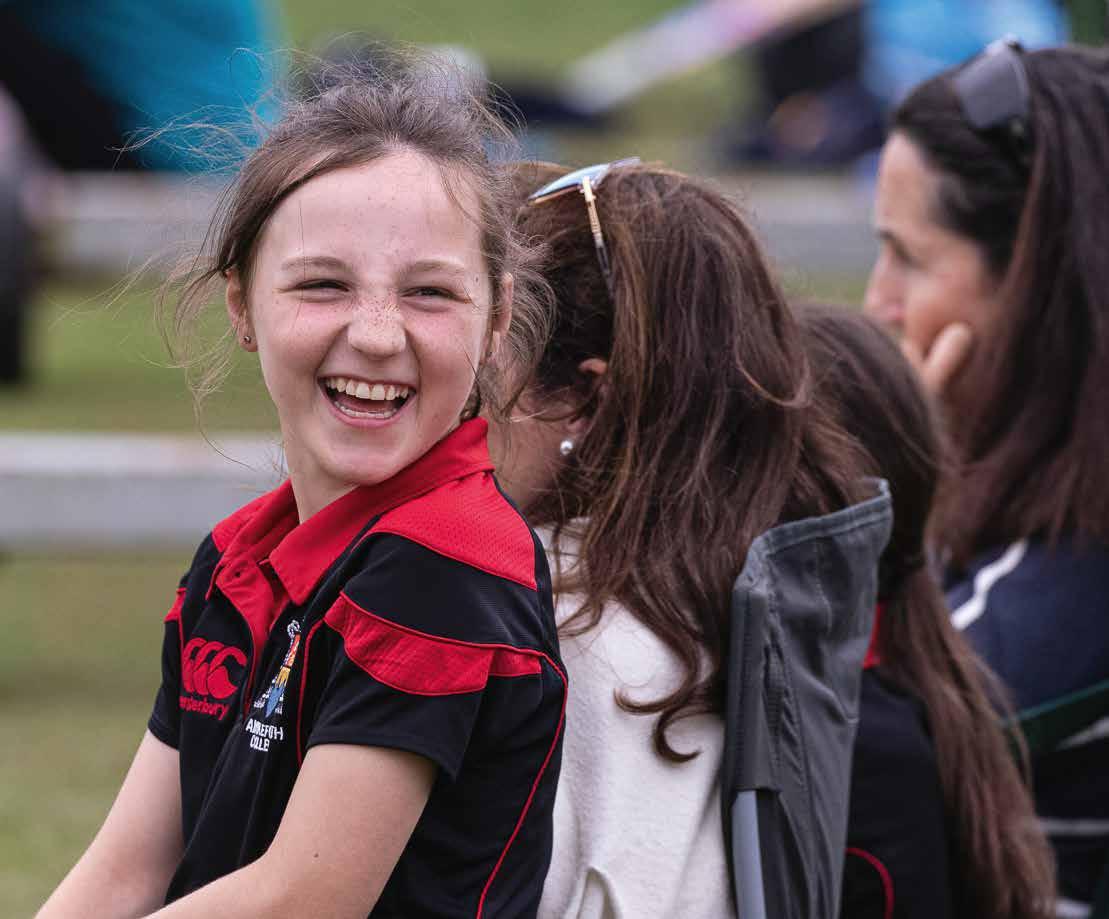
Day trips to York visiting various interesting places and to Saltburn for surfing lessons were much enjoyed, although some aspired to spend more time up on their boards and less in the water! As ever, food featured highly with York market’s street food, and the fish and chips in Saltburn, particular hits. On the Wednesday, both the girls and boys played in the Worsley Cup U13 Cricket Tournament at Ampleforth with the girls finishing as runners-up. Then onto learning and performing an entire play, Jason and the Argonauts, in one day which was quite a feat, before a celebratory BBQ that evening with parents and siblings. At Prize Giving the next morning, we applauded the effort, progress, and achievements of our pupils over the past year and enjoyed the talent showcased on various musical instruments and an inspiring monologue from Ben Michie. After such a busy week, it was a wonder the pupils had any energy left for their athletic endeavours on the last afternoon! As well as all the usual races and events, we had an impromptu 9 x 100m relay involving staff, pupils and parents which the highly competitive dads’ team (they even removed their shoes and socks) won.
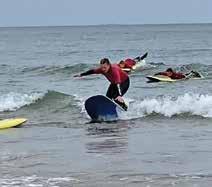


Congratulations to all of our wonderful Junior pupils on their many accomplishments this year and best of luck to those selected as prefects for September.
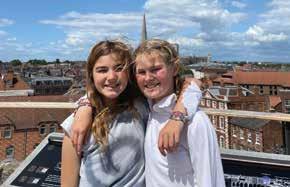

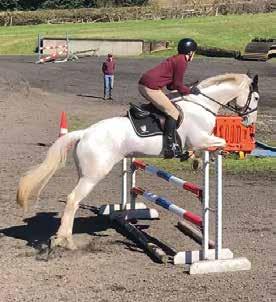 By Eliz Cook, Equestrian Manager
By Eliz Cook, Equestrian Manager
Our equestrian team has had another good year, despite a number of riders retiring, and horses retiring from the competition arena too. Miles Thomas enjoyed the experience of four Masterclass lessons with OA Christopher Bartle, British Eventing Team’s High Performance Coach. Christopher claimed at the end of the lessons that Miles was officially now ‘one of the team’. Miles was also awarded a prize at Exhibition this year for his contribution to the School’s equestrian team.
Maggie Barrow, Olivia Bellamy and Elizabeth Bellamy represented the School at Hickstead in May, at the NSEA Oliver Bonas Showjumping and Le Mieux Eventer’s Challenge Championships. They all represented the school with true professionalism putting in many hours of extra jumping lessons prior to the Championships, with Olivia being rewarded for all the hard work by finishing 5th and 10th respectively in her classes.
Miles, Olivia and Elizabeth have all qualified for the NSEA National Championships at Keysoe in October 2023 too. Well done to them all, a great reflection on their commitment to the equestrian team. Olivia and Elizabeth also received an award at Exhibition for their contribution to the ongoing success of the team at Ampleforth.
The pre-season Simulated Clay Shoot in September went down well with students, a number of whom were accompanied in the gunline by their fathers who shot alongside them. The gun line on the day was presented with some very high and fast clays from above the Gormley statue. We were lucky to have OA Edward Robinson alongside his father and Mike Syms setting the day up. All the students enjoyed pheasant samosas kindly made by the Shoot Captain, Arthur Kavanagh’s mum, Hester Sowerby.
December saw the gun line enjoying a cookery session led by Hester alongside Sophie Legard from Malton Relish. The students learnt how to cook pheasant lasagne and pheasant samosas, with the samosas gobbled up at the shoot day the following weekend. In fact, Hester has kept us well fed on samosas all shoot season!
In January we welcomed Professor Joah Madden from Exeter University to the Valley. Professor Joah, a specialist in animal behaviour, came to see how the shoot works in the valley and how we raise the pheasants in preparation for the season. He gave us a thought-provoking presentation on how to improve the early life of pheasants, alongside the ecological and ethical benefits of releasing birds and the ecological benefits shooting has on the wider environment.
All in all we enjoyed a very successful shoot season, with the beaters providing the gun line with some high and fast birds and some wonderful days shooting (fortunately with only one wet day).

The season culminated with a superb end-of-season dinner, held at Hawkhills, Easingwold, attended by parents, Mr Roberts, and all students and staff involved in the shoot.


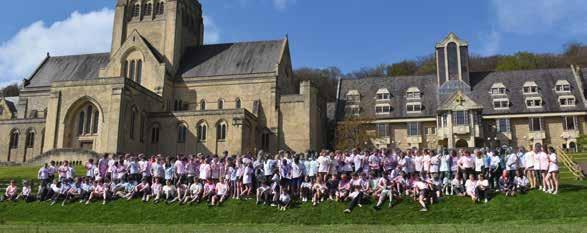
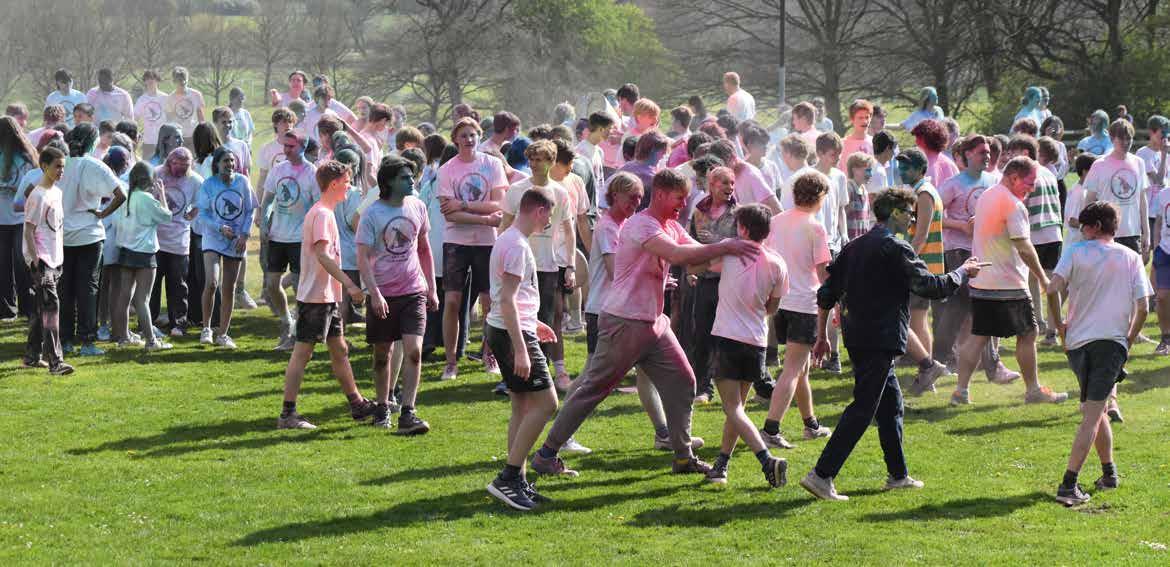

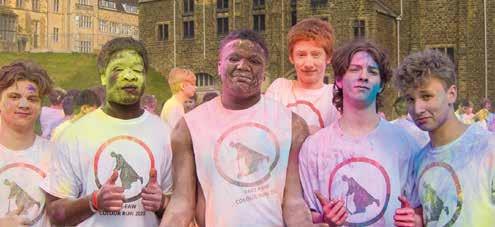
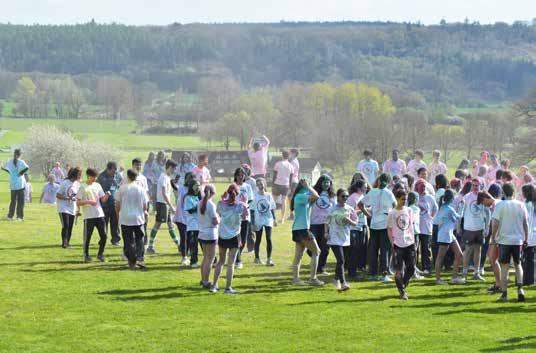 By Josie Blake-James (M) Year 12
By Josie Blake-James (M) Year 12
When I woke up on that inconspicuous Sunday morning, I think becoming an accessory to what can only be described as a rampage was quite possibly last on my agenda. The day was harmless enough at first, it was bright and sunny, and students were scattered around the bounds wearing beautifully designed shirts and glaringly white trainers which begged to be permanently stained by paint.
Students gathered around to be briefed by Mr Davison like ants to honey, feverishly whispering about the chaos which would soon ensue. Colour Run. The fabled war between Houses which left each and every person looking as if they were cosplaying as one of ‘Radiohead’s’ popular albums.
As the Houses were separated and allocated to separate lots of housing barrels and appointed teachers, tensions began to rise. The other pupils disappeared into the distance and suddenly all that mattered was you, your House around you, and the barrels.
I think it was something in the not knowing that drove the students to such chaos. What if the other Houses have begun throwing paint? What if we’re left out? How funny would it be to start before the first House running even passes us?
Needless to say, the restraint broke very quickly. All remnants of civilisation and dignity were left with discarded jumpers at the wall. The once-polite savages began to tear into the barrels of powdered paint, practically tackling the teachers guarding it out of the way. All that mattered was getting your hands into the soft, colourful pile which was depleting at such a fast rate it was worth as much as gold in the eyes of the average participant.
During the gold rush the number of hands which accidentally grabbed each other whilst searching for paint was enough to make a Hallmark movie director cry tears of joy, which would quickly dry as the hands were rapidly snatched away and promptly used to lob a handful of pink mush into the bright neon face of a classmate. I don’t think I’d felt as much adrenaline in years in those first 10 minutes, as I ran blindly through a haze of powder so thick, I could’ve put it on a stick and called it candy floss.
Having been ruthlessly pummelled with paint by people I’d never even spoken to, I could barely manage an orange-stained smile between shouting for my friends, who had been lost so long I was genuinely beginning to think they had become One With The Powder.
Despite all of this, though, we emerged triumphant, suppressing giggles at the yellow splotches on Mrs Paterson’s coat and the lingering look of panic in the eyes of Mr Davison. The first years were doing snow angels on the grass and people were choking on their laughter as they took pictures of their friends. Memories had been made and humanity had been lost. All is well among the empty barrels and purple clover of Ampleforth.
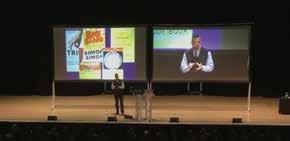 By Hattie Roberts (A) Year 10
By Hattie Roberts (A) Year 10
Science Live was an amazing trip that was a great opportunity for us to learn new things about science. I was able to broaden my horizons to understand many different perspectives on science and how we can help our planet to survive.
I learnt about hydroponics with Professor Tony Ryan in his talk called “Enthusiastic about Plastic”. He talked about how hydroponics was introduced in Za’atari at the refugee camp to help plant life grow in a hot climate without much soil. There is not a lot of water there and plants in soil need 70% water making it close to impossible. It involves mattresses being recycled and used for their foam in which to grow plants. This was a new alternative to soil introduced to help plant life thrive, reduce water consumption, and decrease greenhouse gases.
Dr Kate Lancaster asked the question “Can we build a star on earth?” This could be the solution to our energy crisis. This is nuclear fusion using Deuterium and Tritium giving the resultant products of helium, neutrons, and a large amount of energy. It was extraordinary to hear that a bathtub full of sea water and one laptop could provide a life supply of energy.
Furthermore, Professor Lord Robert Winston gave a talk on how it is possible to modify cells to make them eligible for transplants or to remove genetic defects. We were shown a video of a genetically enhanced mouse and how it could be made faster, stronger, and more resilient due to genetic enhancement.
Next, was a talk about the human brain by Dr Hannah Critchlow. We were taught that the brain can exhibit all sorts of interesting things for example, your synchronicity and how well you would work with other people. We were also shown the interesting idea about how power can influence the way we think and act. “Power tends to corrupt, and absolute power corrupts absolutely.” She finished the talk by saying that we can access 20 Watts of brain power at any point, so imagine what we can do together!
Lastly, we had a fascinating talk on the Big Bang theory all explained in about 25 minutes! Simon Singh said that it was discovered that every galaxy is moving away from us, which therefore means at one stage they all had to be squished together. All in all, a fascinating day.
By Charlotte Goddard, Head of ClassicsOne of the delights of studying Latin, Greek or Ancient History is the opportunity to put classroom studies into context by visiting the sites of significance to Greek or Roman civilisation.
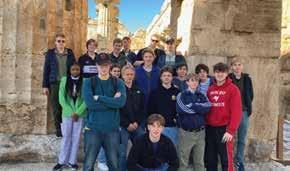

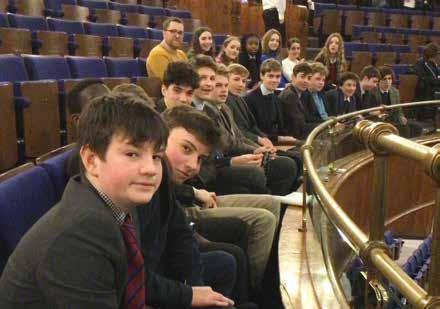

In the February half term, the Classics department led a trip to southern Italy where, from a base in the city of Sorrento, we visited several fascinating archaeological sites. The principal focus of our visits was insight into the Roman empire at the time of the destruction of Vesuvius. Pompeii and Herculaneum, preserved by the very disaster which destroyed them, never cease to fascinate. We came into close contact with Roman life; we saw Pompeiian bar snacks and loaves from bakers’ ovens remarkably preserved after the eruption of Vesuvius. On a more sombre note, we could see the expressions on the faces of the Pompeians in their moments of desperation, preserved in plaster casts, a remarkable relic of nineteenth-century archaeology.
A particular highlight was that the House of the Vettii in Pompeii, famed for its remarkable mythological frescoes, had just reopened to the public.
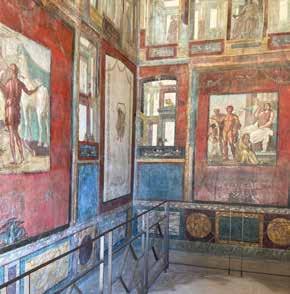
For the students of Ancient History A Level, a visit to Paestum, refreshingly empty at the start of the tourist season, afforded opportunities to see Greek temples as well as Roman public buildings. There the early February sun warranted ice creams, even though a few days previously we had climbed up a snowy Vesuvius.
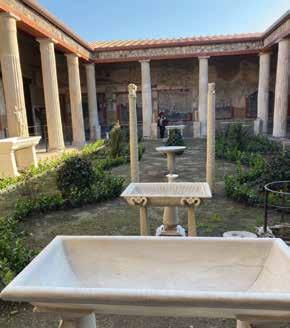
She was in the year above me at university. Two years above Miss Foster. The year below Mr Seymour.
She lived on the same street as me. She was in St Cuthbert’s; I was in St John’s.
Undoubtedly, we were in the same place, at the same time, at some point. After all, she was described as “lively and popular”, and, for three years I worked in the busiest nightclub in the city. I must have served her a drink, pushed past her in a queue, or sang to the same song at closing time.
She was the same age as me.
A friend said that “she had opinions, sarcasm and wanted things to be better.”
Another said that she was “open, honest, unflinching in her ability to listen and empathise.”
She sounds like the kind of young person we encourage you to be, the kind of person you wouldn’t mind being your friend. She was Sarah Everard.
In March 2021, she was murdered. As she walked home from a friend’s house. Unable even to walk the streets of London in safety, with dignity. All because she was a woman who encountered a killer.
Tomorrow is International Women’s Day. The international theme is using technology to achieve gender equality to empower all women and girls. Our theme here at Ampleforth is about living together in dignity so that we can all be empowered.
I know what you might think, here’s some mansplaining going on – a male Housemaster, is about to tell the school why he’s a feminist, why he’s woke. But I’m not here because The Guardian told me to or because it makes me feel better about myself. That would be virtue signaling. Rather, I’m here because I’m Catholic. I believe in Gospel values. I’m a husband. And I’m a father. I’m passionate that each of us treats the other with dignity.
“My challenge to you is to keep calling out indignity and to have the bravery to challenge negative attitudes. Because, ultimately, that empowers us all.”
other people are more important than yourself.” In St Cuthbert’s, on a Sunday evening, we pray to “live in mutual harmony”. To live that way is dignified. But it does take bravery.
Fr Philip told us that on Sunday in Mass – that often a Christian life can be difficult, a challenge, not easy. Too often, in our everyday interactions, we get it wrong. We don’t treat each other with dignity. We think about ourselves, and what we want. We aren’t brave enough to speak up and speak out.
So, how can I believe in Gospel values, how can I be a parent – let alone a Houseparent – if I’m not brave enough to stand up on International Women’s Day and call out that this isn’t just happening in a distant village in central Africa, or a favella in South America. This isn’t happening in cultures we don’t understand. It is happening here – online, in our cities, amongst our friends. Here, in our school.
The testimony on Everyone’s Invited and in work that we have done with you in Houses and Christian Living suggests that this is a culture that exists on your Snapchat, on your holidays and at your parties. So ask yourself, am I treating others with dignity? Am I treating myself with dignity? And if you see someone abusing another’s dignity, online or in person, will you be brave enough to speak out about it?
After thirteen years, I’m leaving Ampleforth soon. But, on International Women’s Day, I’m proud that you students have developed a far greater awareness of what dignity in friendship really looks like. In many ways, this is a far gentler school than the one I joined and, frankly, I think it’s a far nicer one to be a teenager in.
But, you can’t be complacent in dignity or just feeling that you are decent human being.
Sarah Everard was a normal person. She lived a dignified life. I’m sure she wasn’t a saint, because few of us are. But she died partly because the society that existed around her murderer wasn’t brave enough to call out his attitudes and his behaviour. He treated others without dignity, and too many were ready to turn a blind eye.
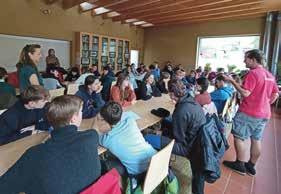 By Felicity Cunningham (A) Year 12
By Felicity Cunningham (A) Year 12
In the autumn term of 2019, I successfully applied to be part of the Erasmus Plus scheme. I was particularly interested in being involved because I thought it would be interesting to meet other students from across the European Union. This is a scheme where groups of schools in the EU apply for funding to work collaboratively on projects. However, because of Brexit, Britain has had to withdraw from the scheme and Ampleforth was one of the last British schools ever to participate.
We teamed up with Benedictine schools in Germany and Ireland, and a Catholic school in Czechia, to work on environmental protection measures. The teachers from the four schools started planning our visits in the spring term of 2020, and in the meantime we all had our first meeting online via Teams. Unfortunately, the opportunity to travel and meet in person had to be delayed because of travel restrictions put in place due to Covid-19.
Because of the significant time delays created by Covid-19, by May 2022, when the first in-person trip happened, many of the original group, including myself, were unable to attend because we were taking our GCSEs. This opened the project up to other year groups and they travelled first to Ireland. They began with a few days on Inismor, where they learned about the sustainable lifestyle there and got to know each other, breaking down barriers of language, culture, and age, before visiting the host school, Glenstal Abbey.
The final visit, in March 2023, was to Ampleforth. By this stage, much time was spent in the classroom, completing projects and preparing presentations. We also managed to fit in trips to tour Whitby, visit York, and do some water sampling on the river Rye, courtesy of the Ryevitalise project in nearby Duncombe Park. We finished with a spectacular presentation of all our hard work over many years which featured a recipe book of eco-friendly national dishes, leaflets on renewable energy and cleaner transport, and clothing swap-shops being put in place in every school.
Although the project took far longer than could have been anticipated when it first started, and it changed to accommodate the challenges of Covid-19, I very much enjoyed being part of it. I have spoken to students who went on the trips I wasn’t able to participate in, and there seems to be a mutual feeling that we learnt a lot and enjoyed the whole experience thoroughly. Lasting friendships were formed and at our closing party, we sang a rousing version of ‘Thank you for Erasmus’ along with Abba, in English, German and Czech.
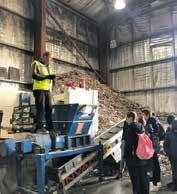

I would like Dr Goddard for her planning skills and hard work, and Dr Vowles who helped enormously on the visits.
Fr Richard tells us often in his homilies that “love is living as though
So, my challenge to you is to keep calling out indignity and to have the bravery to challenge negative attitudes. Because, ultimately, that empowers us all.
The following September, another group of students from a mix of years was able to go to Czechia, where visits included an eco-village and a natural water treatment plant, and group work began to take root in earnest. Finally, 3 ½ years after I had first applied to Erasmus, I was able to go to our penultimate meeting in Germany, where we toured the school’s biomass generator, visited an organic vineyard, and continued with our group work for the projects.
On 18 October 2022, a group of six Year 12s visited St Pio’s Friary in Bradford, where, since 2006, the Friars have opened their doors as a soup kitchen to offer food and friendship to the poor and hungry. Seamus Stainton shares his thoughts.

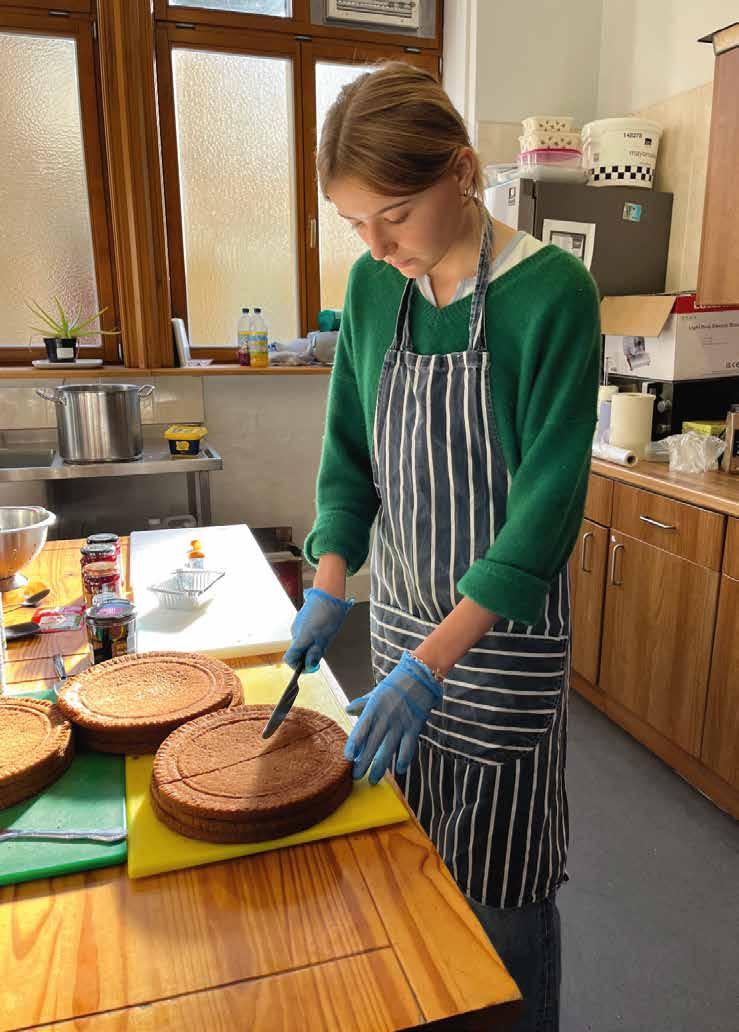
As we drove past the friary, an hour before the soup kitchen would open its doors, we found a queue already long formed. The queue was made up of the poor and hungry and they were waiting patiently and amicably, lined right back up the street. The friars refer to these people as clients and neighbours and we were to learn that this stream of people, strangers to us, were friends to each other, a community of regulars, coming not only for food and drink, but companionship, and the comfort and solace that comes with sharing food in good company.
When we arrived, we were greeted by Brothers Samuel and Jonathan. Their obvious Bronx accents provided an incongruous note to their presence in Bradford. Guided to the kitchen by Brother Jonathan, who walked down the street barefoot, much to the amusement of the people queuing outside the Friary for lunch, we were introduced to a motley collection of volunteers in the kitchen: two teams working away – one making sandwiches and preparing food, and another bagging up ready for service. We were dressed with pinnies and put straight to work assorting sandwiches, crisps and biscuits into bags, to be distributed when lunch began. It was notable the care with which the volunteers had prepared different flavoured sandwiches to cater to choice and differing tastes and needs. There was no expectation that the hungry should simply be grateful for what they received. On the contrary, the provision of choice emphasised this was a service of care and love, and it provided a simple dignity to this act of giving.
After all the sandwiches were packaged some of us spoke with Matt, a volunteer with an avid love for golf, who showed us how the Friary did not only provide disadvantaged people with food but also clothing, the majority of which are donated by people throughout the city. This led Miss Foster to think of all the unused clothes in storage throughout the school, which could be donated to a charitable institution, such as St Pio’s.
At 11am the lunch service began. Fathers John-Bosco and Jacob led us in a beautiful prayer, in which we prayed that the lunch would be successful and that all those who came would leave physically and spiritually nourished. While Felicity, Evie and I helped to prepare a pudding of chocolate cake, fruit and custard, the others were ‘front of house’, standing behind tables beneath an opened garage door, where the lunch bags were distributed along with soup, coffee or tea. George and Seb helped to give out sandwiches to those who wanted them, while Lara was out in charge of making teas and coffees. The tables were also laden with other salvaged food from supermarkets that would otherwise have gone to waste, chiefly fruit and veg, but also some milk drinks and other treats.
It was estimated that 150 people were fed in the hour that the Friary was open for lunch, a number that has grown enormously in recent years. Before the pandemic, the community provided food for about 30 regulars, a number which allowed the community to come inside to eat. Now, with such numbers, the neighbours congregate outside, sharing conversation on the steps of the church and on chairs in a makeshift outdoor common room.
Brother Samuel then took us to sit and reflect on what we had just been lucky enough to take part in. He read from the Gospel of Mathew, Chapter 25, reminding us of Jesus’ words that what “you do to the least of these brothers of mine, you do to me”. We then reflected on the duality of charity and how we, as volunteers, benefit from charity just like those who receive it. Everyone gave personal reflections on the trip, with some people commenting on the peaceful aura of the Friary and others on the look of love on the faces of those people being handed the lunch. Words such as ‘eye-opening’, ‘calming’ and ‘powerful’ were used to describe the experience.
Brother Samuel was then generous enough to give us our own lunch. Quiche was on the menu, as well as cups of tea and coffee. We then said goodbye to everyone at St Pio’s and set off on the journey home, with everyone agreeing that it was a humbling and moving experience.
 By Alix Hamilton (A) Year 12 & Lucy Barrett (B) Year 12
By Alix Hamilton (A) Year 12 & Lucy Barrett (B) Year 12
Seven of Ampleforth’s music students were lucky enough to perform at Ripon Cathedral as part of their programme of weekly lunchtime recitals. There was a range of instruments as well as styles played by students from Years 9-12. It was lovely to perform for such a responsive audience that was so large they filled even the back rows. Many stayed afterwards to thank us for playing and Mr Seymour, Director of Music, even received an appreciative email later that day:
“My wife and I have assiduously travelled from Teesside to the Ripon Lunchtime Concerts for many years, often not knowing what is to come. I wasn’t eager to come to hear a group of school kids but wow, this was one of the best concerts I have been to. It is enough at their age to be technically good, but I was particularly taken by the musicality from all of your proteges.”
As soon as we all stepped into the Cathedral, we realised how special this concert would be from the sheer beauty of the architecture and the friendliness of the audience. The talent displayed by all who performed was captured by the gorgeous acoustic in
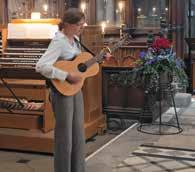
the Cathedral which really helped bring to life each performance. Two of us wanted to express our own experiences of the day:
“I really enjoyed playing a Bach Pastorale on the choir organ. It was a different experience to play on an organ where the pipes surrounded the concert space and the sound felt much more distant than what I am used to. I really appreciated playing such a beautiful instrument which made such a magnificent sound.” – Alix

“I had an amazing experience while performing my piece on the flute – Fantasie No.7 by Telemann – and was overjoyed to be able to play to such a supportive audience. Also, I had so much fun playing in the perfect acoustic for an unaccompanied solo piece for flute where the sound was allowed to fully resonate. The space really fulfilled the sound which Telemann intended. I’m so grateful for this experience .” – Lucy
We both thought that this was an amazing opportunity to perform, not only because of the amazing space and heart-warming responses we received, but also how much we all learnt and gained confidence through the experience.
This year, every year group has been given a focus for charitable fundraising for our school charity FACE-FAW. For Year 12, this has been learning about homelessness, its causes and effects, as well as raising money for some local charities which provide support and service for the poor, hungry and destitute.
The Oxford definition of homelessness is “the state of having no home”. However even if you do have a roof over your head, you can still be considered homeless: if you are staying with friends or family for an extended period, or living at a hostel, you may technically be classed as homeless. Some people become homeless when something in their lives triggers a moment of crisis, such as escaping a home due to domestic abuse, or if your house has fallen into poor conditions, unsuitable for healthy living. Other causes for homelessness can range from gambling, drug and alcohol addictions, financial mismanagement, mental health problems and illnesses (this has become more prevalent in the past couple of years thanks to Covid-19).
A potentially growing cause recently is the cost-ofliving crisis. The cost-of-living crisis has been putting pressure on household incomes, and those making mortgage repayments or paying rental income may find their monthly payments have risen beyond levels that they can afford. This in turn can lead to homelessness either from mortgage defaults, leading to a loss of property or eviction from rental housing.
A particular form of homelessness is classed as rough sleeping. Rough sleeping is typically associated with sleeping outside but also refers to sleeping in a place not designed for living. The difference between homelessness and rough sleeping is that rough sleeping can be voluntary unlike homelessness which is usually forced upon them.
It is very hard to accurately gauge the numbers of homeless, as there may be many ‘hidden homeless’ persons (such as sofa surfers) who don’t ever make it onto the official records. It is also very difficult to count the number of rough sleepers at any given time. Official estimates of rough sleepers counted in a single night, for example, put the figure at approximately 2,500 in the UK; however, the Combined Homelessness and Information Network (CHAIN) figures reported that 8,239 rough sleepers were spotted throughout a year in London alone. A report released in December 2021 by the homeless charity Shelter, suggested more that 274,000 people were homeless in England, including 126,000 children. Shelter’s analysis of official rough sleeping and temporary accommodation figures shows
that one in every 206 people in England are currently without a home. Of these, 2,700 people are sleeping rough on any given night, nearly 15,000 single people are in direct access hostels and nearly 250,000 people are living in temporary accommodation – most of whom are families. The same charity reports that 74,234 households in England became homeless or were at imminent risk of becoming homeless between January and March 2022 – including 25,610 families with children. This represents an 11% rise in three months.
The Rich Man and Lazarus
19 “There was a rich man who was dressed in purple and fine linen and lived in luxury every day. 20 At his gate was laid a beggar named Lazarus, covered with sores 21 and longing to eat what fell from the rich man’s table. Even the dogs came and licked his sores.
22 “The time came when the beggar died and the angels carried him to Abraham’s side. The rich man also died and was buried. 23 In Hades, where he was in torment, he looked up and saw Abraham far away, with Lazarus by his side. 24 So he called to him, ‘Father Abraham, have pity on me and send Lazarus to dip the tip of his finger in water and cool my tongue, because I am in agony in this fire.’
25 “But Abraham replied, ‘Son, remember that in your lifetime you received your good things, while Lazarus received bad things, but now he is comforted here and you are in agony. 26 And besides all this, between us and you a great chasm has been set in place, so that those who want to go from here to you cannot, nor can anyone cross over from there to us.’

27 “He answered, ‘Then I beg you, father, send Lazarus to my family, 28 for I have five brothers. Let him warn them, so that they will not also come to this place of torment.’
29 “Abraham replied, ‘They have Moses and the Prophets; let them listen to them.’
30 “‘No, father Abraham,’ he said, ‘but if someone from the dead goes to them, they will repent.’
31 “He said to him, ‘If they do not listen to Moses and the Prophets, they will not be convinced even if someone rises from the dead.’”
The Year 12 response through FACE-FAW for homelessness included a sleepout to raise money for charities which work with and provide services for the poor, the needy and the homeless. You can read more about this on the next page.
On Saturday 19 November 2022, 14 Year 12 students, alongside Mr Davison, Miss Foster and Mr Hudson, embarked on a sleep-out, the school’s first since Covid. We were going to spend the night exposed to the cold, sleeping on the balcony outside the Sunley Centre with nothing but a sleeping bag, a roll mat, and some cardboard to provide insulation against the cold ground and icy air, and what’s more, the forecast provided little comfort: it was going to get colder and wetter.


Our aim was in part to learn a little about what it feels like to sleep rough and to raise money for St Pio’s soup kitchen and St George’s Crypt, a homeless shelter. St Pio’s soup kitchen in Bradford, is run by Franciscan monks and every Monday, Tuesday and Thursday, from 11am- 1pm, serve sandwiches and soup as well as coffee and tea and offer their warm hospitality to all those who approach them. St George’s Crypt offer care and hope to the homeless and vulnerable all year round. Last year they provided 12,382 showers, 10,920 beds and 65,000 hot meals. Both provide invaluable services for the homeless and our fundraising is so important to enable places like these to carry on supporting the people they do.
On Friday 14 October, two climate activists threw cans of Heinz tomato soup at Van Gogh’s painting Sunflowers in London’s national art gallery and then superglued their hands to the wall whilst they gave a speech about oil drilling and the cost-of-living crisis. This was the action which begun a series of protests where members of the group “Just Stop Oil” followed similar actions, such as throwing mashed potato at a Monet and cake at the Mona Lisa. This movement has been heavily documented by the media across all platforms, garnering attention from millions of people, however not all of the attention has been positive.
Upon first seeing a video of the initial protest, I thought it was ridiculous, and as someone who dedicates a lot of time to art, was appalled. Despite this, I read further articles and watched more videos about who they are and why they are doing what they’re doing, and I was swayed slightly.
Some people criticise the action by saying that there are better ways to go about it, such as signing petitions or writing to your local MP, however in a video posted by The Guardian an activist in an interview said “People ask ‘Why don’t you write petitions? Why don’t you stand outside of parliament?’ The thing is we did, you just didn’t hear about it because the [media] doesn’t cover it, so this is what we have to do to talk to [reporters] to get the message out there, to get people to care”.
It is ignorant to label the protesters as idiotic or arrogant because in reality, they know exactly what they’re doing. They recognise that doing this is what will gain them the most attention, and that spurs them to research why they are doing it (as I have done here) and learn about the movement and what they can do to help.

Our expectations of the night were somewhat pessimistic when the weather forecast told us it was going to be 4 degrees and raining in the early hours of Sunday morning. Nevertheless, we kept our spirits high, aided by Mr Davison’s ghost story and the sight of the tarpaulin which was going to be our windbreaker for the night, as well as the constant flow of food, tea and hot chocolate, which was very appreciated by everyone as the temperature began to drop. Later, Fr Ambrose joined us for Compline which gave us time to remember why we were doing the sleep-out. We used this time to offer our prayers for the homeless and vulnerable. Throughout the night, I know I speak for everyone when I say how thankful I was for the tarpaulin, as the wind picked up and the rain came pouring down, yet once we had weathered the storm, the morning was far more peaceful as we reflected on our experience and shared our thoughts.
The important reminder to take away from the night was, whilst we were sleeping outside, we had the comforting knowledge that a warm bed and shower were awaiting us. Yet for so many this isn’t the case, and they have an indefinite idea of when they will next be sleeping in warmth. Many have responsibilities in the day, which they have to manage after having slept (if they managed to sleep at all) in the cold and all manner of weather. Also, we were visited by a welcoming and caring community, offering us the kind of comforts that nobody sleeping on the streets might hope to receive. The sleepout made me realise how challenging being homeless is, and yet we only slept out for one night. It made me understand how we must do all we can to help and support charities which provide warmth and comfort to all those who require it.
As a teenager, I am a part of the next generation of leaders, parents and politicians, I am watching the damage being done to the environment and realising that much of it is irreversible. I have to worry about my future in a world that has been destroyed by power hungry oil drillers and huge corporations which flatten entire rainforests- so it goes without saying that I am heavily concerned about the lack of action being taken to attempt to fix what still can be aided. This leads me to sympathise with the activists, who are actually actively trying to make a change, which is arguably impressive regardless of the ways in which they have gone about it. Furthermore, I think that their method, whist controversial, has been effective in exactly the way they intended it to be, going viral on platforms such as Instagram and TikTok, which target a demographic of mostly younger people, where the future lies.
In an interview with one of the activists who threw the soup, she said “I would just like to clarify that there was no damage done to the painting […] It was behind glass and we would have never, ever considered doing it if we didn’t know it was behind glass” exemplifying the fact that their actions were very deliberate and not intended as a crime against art. She also said “I recognise that it was a slightly ridiculous action, I agree it is ridiculous. But we’re not asking the question should everybody be throwing soup at paintings, what we’re doing is getting the conversation going so we can ask the questions that matter. Questions like ‘Is it ok that Liz Truss is licensing over 100 new fossil fuel licenses? Is it ok that fossil fuels are subsidised over 30 times more than renewables when offshore wind is currently nine times cheaper?”.
This offers a sufficient case for the justification of her and her fellow activists’ actions, as, whilst her actions may seem extreme and unnecessary, at the end of the day they aren’t harming anybody and are communicating their message efficiently. This is why I believe that the movement of throwing food at famous paintings, while mildly obscene, is effective and therefore should not be chastised. Instead of looking down on them as “hippies”, people in positions of authority should look at themselves and think about the fact that they have driven them to do this.

I’m here today to talk to you all about stewardship. So, what is stewardship? Most of us know it as one of our school values or perhaps a topic covered in a Geography or CT lesson. Although it is important that we discuss stewardship in our classrooms and boarding houses, only doing so does not give the topic the respect or attention it deserves. Stewardship is one of the most important topics discussed in government buildings and international meetings today, and it is just as important that we, the generation which will be so crucial in the future of this planet, are educated on the matter.
Acting as a steward is being responsible for and caring for our planet. As humans we have a moral responsibility to act as stewards for the environment.
For some, such as many of us, this moral responsibility stems from a Christian belief that everything we have is a gift from God and therefore we should treat the earth as the precious gift it is. For others, the feeling of responsibility is simply due to a desire to preserve nature and maintain a healthy relationship with our planet, safeguarding it for future generations.
Many people speak about stewardship and caring for our environment in a pessimistic way, pontificating about daunting facts surrounding the extinction of animals or global catastrophes; aiming to scare people into action.

I’m sure many of you began to switch off when you realised what I would be talking about today.
However, today I want to tell you some stories of people and organisations taking the initiative to act as stewards for the
environment, in the hopes that they inspire you to consider your own actions and their impact.

One such example is our own country, the United Kingdom, which has become the first country with a developed economy to begin passing laws to end its contribution to climate change by 2050. This commitment to becoming net-zero is one which is spurring other nations into action. This commitment to being stewards of the earth should inspire and encourage us into doing our part in caring for the planet.
Around the world young people are being inspired by similar acts of stewardship.
Organisations such as Unicef support young activists in setting up initiatives to care for the planet and reduce our impact on the environment. I’m sure we have all heard of Greta Thumberg and the inspirational way in which she lives her life and encourages others to follow her lead.
Another example of global organisations committing to care for the planet is the Great Blue Wall initiative, something you may have read in the news recently. The organisation was formed to aid sustainable development in countries in the Western Indian Ocean. These countries, such as Mozambique, the Seychelles and Somalia, aim to protect 30% of the Indian Ocean by 2030. The Great Blue Wall initiative provides financial aid for these countries whilst also helping government bodies to build sustainable ‘blue’ economies, which do not impact the ocean. The regeneration of the West Indian Ocean will provide sustainable income for over 70 million
people, whilst also offsetting the emissions of the region through the reintroduction of ocean-plant life. Finally, Pope Francis calls all young people to be stewards of the earth in his letter, Laudato si. He highlights the obligation we have to care for all that has been given out of love, and to respect the Creator who gave it. He says “all of us can cooperate as instruments of God, in caring for his creation; each according to our culture, experience, involvements and talents”. I encourage you to remember this statement and deeply consider your role as a steward for the earth. Consider how your actions impact your immediate and wider environment.
I know sometimes the task of stewardship and being responsible of the planet seems daunting, and even insurmountable, but I ask each of you as Catholics, Christians and Amplefordian’s to remember even the smallest actions can create positive change. Remember the words of the Chinese philosopher Lau Tzu, “the journey of a thousand miles, begins with one step” –everyone in this room has the potential to make a positive impact.
Afew weeks ago, students had the privilege of listening to Harry Blakiston Houston (EW14) talk about his charity Insulate Ukraine.

The charity designs, manufactures and supplies polyethylene windows to protect and insulate houses where windows have been shattered due to the war. His inspiration to set up this initiative was his desire to apply engineering to the humanitarian sector as well as a visit to Izyum in eastern Ukraine, which is close to the Russian border and has been devastatingly affected by the war. The fact that he is a highly qualified and trained engineer, who received good schooling, doesn’t explain why he wished to do this. The why came from both his Ampleforth education and his confirmation saint, St Francis of Assisi. His Ampleforth education affects the choices that he makes as an engineer and he explained how the mission statement, A Compass for Life has provided him with a direction to point his abilities towards. From St. Francis of Assisi, he was influenced by his prayer, Lord, make me an instrument of your peace: where there is hatred, let me sow love
Harry sought a problem which he could solve using his engineering skills in Ukraine. In Izyum, he saw how many homes had shattered windows and, with winter coming, it was going to get very cold and houses would be without proper insulation. The solution people were using was typically a board of plywood, but this was a problem: the boards let no light in, were susceptible to damp, and needed skilled labour to install. In his search for an answer, Harry came up with numerous different ideas. This shows the sheer determination which he had to solve this issue, and it is truly commendable.
The current design which is being installed into people’s houses includes four layers of polyethylene sheet and PVC piping. This allows light to enter in, while being a cheap but effective source of insulation which keeps
By Lara Evans (M) Year 12people protected in their homes. To make sure this design worked, it had to be installed into a home in Ukraine and tested. The tests showed an improvement in the temperature of the internal surface of the window from 1 degree to 23 degrees. Another example of the brilliant work of Insulate Ukraine is when they installed their windows into an old four-storey, Soviet building where Svetlana, a granny, lived. When they walked in there was no difference in temperature to the weather outside which was -15 degrees. Within 4 hours they had installed windows and they could instantly feel the temperature increase and it was notably warmer.
Insulate Ukraine is now set up as a legal entity in Belgium and has backing from inter alia BPL Global and, soon, World Jewish Relief. It is already working in its target locations in eastern and southern Ukraine, and Harry is hoping for further help from larger organisations such as the UN so as to enable his initiative to make a radical difference to the victims of the war in Ukraine.
The work of the whole of Insulate Ukraine is amazing and everybody at the talk was inspired by Harry’s work ethic in persevering with the challenge he had set himself, as well as the care he had for those affected by the war.
“I know sometimes the task of stewardship and being responsible of the planet seems daunting, and even insurmountable”Harry Blakiston Houston with Masha and Oleksii, two of our Ukrainian students


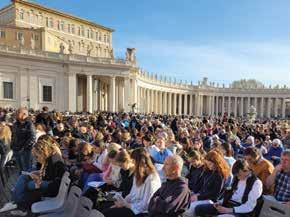

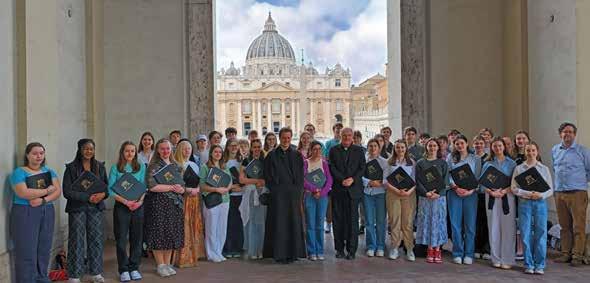 By Alix Hamilton (A) Year 12
By Alix Hamilton (A) Year 12
At 1am on 29 March 2023, the Schola Cantorum left Ampleforth College to go to Rome – the cradle of western civilisation and the centre of the Catholic Church. There are more than 900 churches in this city, all as magnificent and breathtaking as each other and we were lucky enough to sing in several of them, including St Peter’s Basilica. The trip to Rome was an enriching and memorable experience for many reasons. Because of the place itself and the countless number of beautiful buildings, because of the fascinating visits and also because of the spiritual experiences. These are some of my highlights.

On the morning of 30 March, we walked through the beautiful city of Rome to the Vatican to meet Cardinal Roche, Prefect of the Dicastery for Divine Worship and the Discipline of the Sacraments. We went into one of the buildings on St Peter’s Square where he spoke to us and introduced us to Father Pierre Paul, director of the Capella Giulia, the choir of St Peter’s Basilica. After introducing himself, Father Pierre Paul asked us to sing to him as a way of introducing ourselves. This was a little unexpected, however we took out our folders and sang Mother of God by Tavener. We were all standing in a random formation facing different ways and we hadn’t warmed up our voices, but we sang well and Father Pierre Paul was moved and impressed by our singing. He wrote a letter to us congratulating us on our singing and gave us a set of masses by Animuccia, a 16th century composer of liturgical music. In this letter he wrote “I hope that this First Book of Masses by Giovanni Animuccia will be an incentive for you to continue with renewed enthusiasm to inflame hearts with your singing!”
On 1 April, the Saturday before Palm Sunday, we made our way to St Peter’s Basilica and got tickets to climb the dome. After climbing an infinite number of spiral staircases, gradually getting narrower and narrower as we got closer to the top, we stepped outside and had a stunning 360 view of Rome. Fr Henry climbed up with us and refused to take the lift, which was impressive. We could see the Colosseum, the Vatican Gardens, St Peter’s square and mountains on the horizon. After coming back down from the top of the dome, we went inside the
Basilica and were allowed through to the very back of the basilica where we got robed. We then sang mass in this breathtaking and vast space. The tourists who were coming in and out of the basilica stopped to listen to our singing and before we knew it hundreds of people were listening to us. Unfortunately, near the very end of the mass, whilst we were singing our very last piece, the Italian singers beckoned for us to stop singing since the next mass was about to start. We therefore had to stop mid piece, fortunately at a relatively convenient moment in the piece, and hurried out. It was definitely a memorable experience both because of the surreality of singing in such a building and because of the unexpected ending of the mass!
On Palm Sunday, we attended the Papal mass in St Peter’s Square in the Vatican. After queueing for an hour, we found our places quite near the front. The whole experience was amazing because of the sheer number of people attending – the crowd filled the whole square and continued down the street behind us. It was also incredible to see the Pope who had, only hours before, just come out of hospital. The fact that he was able to come and the huge support and cheers he got from the crowd after mass was very moving. The mass was in Italian, however the bidding prayers were done in many different languages which reminded us of the diversity of the Catholic Church. The Gospel Reading was the Passion of Christ and what I found especially incredible about it was that the crowd in the reading which shouts “Crucify Him” was represented by the choir who would sing these responses. This brought the reading to life and made it all the more powerful.
The final highlight of this trip was visiting Monte Cassino because it has such close links with Ampleforth. Monte Cassino is a working monastery at the top of a mountain close to Rome with a magnificent view. It is such a peaceful place. We were able to sing mass in the crypt of this monastery where St Benedict and his twin sister St Scholastica are buried. This mass, celebrated by Fr Henry, was a way of providing closure to the trip –it was very memorable because of the significance of the place. We were also given a tour of the monastery and saw St Benedict’s cell.
Overall, I speak for everyone who went on the trip when I say that it was an incredible experience in many ways and also very memorable. We had a really fun time and were able to become closer as one big choir instead of a random mix of Ampleforth students of different ages. The level of singing from the Schola significantly improved. I think that this is because we were not singing in places we’re used to singing in, such as Ampleforth Abbey, but in magnificent and intricately decorated churches. Everyone gave it their all since the trip was a once in a lifetime experience.


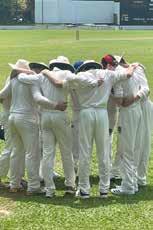
 By James Deacy (H) Year 10
By James Deacy (H) Year 10
On going to bed, many of us felt apprehensive about the 5am wake up set for us on the fifth day, but we soon learnt that it was worth the temporary pain. We travelled to Sigiriya Rock, a wonder of the world, at dawn and watched the sun rise over Sri Lanka’s breathtaking jungle and mountains. This glorious ascent turned to be a symbolic reflection for the games ahead, with both girls and boys winning their next matches. Still, what comes up, must go down and that was the case with a somewhat humbling experience for the Colts cricket team. After a solid start in the field, we held our opposition to 219 in 40 overs. After this long and drawn-out innings, we were somewhat expecting to be batting for another hour or two in the heat. This was, sadly, not the case. We were bowled out within 8 overs

by two exceptional spinners, one of whom took 5 wickets in all. We were quickly able to put that game behind us though, as we travelled to the Temple of the Sacred Tooth, the most important Buddhist relic in Sri Lanka. The gold and ivory covering the temple was a somewhat stark difference to the abbey church that we were used to but it was fascinating to learn about the history of Buddhism and while continuing our tour of Sri Lanka, we were able to visit a tea factory as well as an elephant orphanage.
The penultimate day held our final fixtures in Sri Lanka. We visited the Foundation of Goodness, a charity that helps children from the Sri Lankan countryside and gives them an education and sporting opportunities. The boys faced a foundation cricket team while the girls played them in netball. Both
ended in defeat, but we were all inspired by the amazing work that the charity did. The evening held an awards ceremony for the tourists and for Ravi and Rohan, our excellent tour guides.
On the final day of the tour, we visited a turtle hatchery, and had the incredible opportunity to release some baby turtles into the wild by hand. We then travelled on a boat cruise around the Madu River and had a first-hand experience on how different cinnamon products were made from some locals on an island there.
All in all, it was an absolutely incredible trip in which we had some unbelievable opportunities. We all feel sincerely grateful to the teachers who organised it, and I think it’s safe to say we will cherish these memories forever.

Training on the beach followed by a delicious, if spicy, lunch at the Mount Lavinia Hotel, set the tone for a tour packed with excitement, adventure and new experiences.

Whether the tears shed at the lunch table were of pure happiness or down to the chillis in the fish curry I’m not sure, but there was certainly an air of cheeriness among the tourists on what was a great way to begin our time in Sri Lanka.
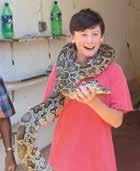

Our fixtures began with the girls facing St Bridget’s in netball and the boys taking on two St Thomas’ sides in rugby. A victory for the girls and a win and a draw for the boys (including two fine tries from Bell and Deacy, which Mr Phillips rated as the best he had seen in the last three years) built up confidence for the fixtures ahead. But this was a multisport tour, and the next day brought cricket along with the sunshine, with both girls’ and boys’ teams facing Mercantile Academy and Kingfisher Academy respectively. It’s possible that the
heat got the better of both sides, or perhaps it was the difficulty in adjusting to the Sri Lankan wickets, but both matches ended in defeat for the tourists. Despite this, a positive contribution from Freeland with an extremely accomplished half century in the 30° heat maintained our spirits.
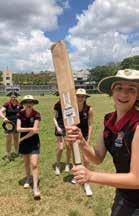
Then came the first of a number of interludes from the sports fields: we were lucky enough to experience a jeep safari. We saw lots of elephants and took in some spectacular savannah scenery. And then something extraordinary and eye-opening happened. On our way to the hotel after the safari, Mrs Edgar and Mr Jackson came to the rescue of a young local boy who had seriously injured his foot while riding his bike.
Without the antiseptics in the Ampleforth first aid kit, the boy could have potentially died if his wound had been infected. It was inspirational to see our teachers potentially save someone’s life after reacting proactively on seeing the hubbub of a crowd as we passed in our bus.
For those who don’t know me, I am Mr Devitt, the Deputy Head Academic. In the same way that Mr Mutton has responsibility for your well-being and what happens in your boarding Houses, I have responsibility for what happens in the classroom, your effort grades and how our exams run and how we make sure that everything is in place to enable you to perform as best as possible in your studies, as we prepare you for life after Ampleforth.
I am going to begin by reading to you our mission statement:
“An Ampleforth Education is an invitation to young people to discover the value and the purpose of life, by entering into a transforming encounter with Christ through active participation in the life of a living Christian Community.”
So – “What’s it all about?” I ask this last part because recently in talking to some of my fellow teachers, some of our students, particularly sixth formers have been asking “What’s it all about?”, “What’s the purpose of what we do here at Ampleforth? ”.
I’m going to give you my version of “What it’s all about”, starting with a line from the rule of St Benedict –“We must do now what will profit us forever”.
“An Ampleforth Education is an invitation to young people to discover the value and the purpose of life, by entering into a transforming encounter with Christ through active participation in the life of a living Christian Community”.
Can I repeat:
• the value and the purpose of life
• a transforming encounter with Christ
• through active participation in the life of a living Christian Community
If I take your studies, do you approach lessons and events thinking “what’s in this for me” and if there isn’t anything, you tune out or do your own thing. I’m talking about what happens in the classroom, but I could just as easily be talking about the Netball court, Schola, any of your activities, or your boarding Houses.
If your first thought is “what’s in this for me”, then I’m afraid you have already lost – you are tearing up the winning lottery ticket, which is this community. You are passing up on your opportunity to transform others and for them to transform you. “What’s it all about” – it is about community and working together to transform each other. Why? Because we need to see Christ in each other to make others more important than ourselves. We need to welcome each other as if we are welcoming Christ, we need to listen to each other as if it were Christ, we need to address each other with care and love and respect as if we were addressing Christ.
We are a community that meets around the altar, the dining table in the Refectory, and the table in the classroom. Being academic is a state of mind, a willingness to know more and learn more, a behaviour everyone can show whether you’re strong in a subject or not. Everyone can want to know more and to be better.
For me and a good many of you already, the “what’s it all about”, instead of “what’s in this for me”, means we instead approach each lesson and say to ourselves and each other – “I’m going to do everything in my power to make this the best 50 minute lesson possible so that my classmates have the best experience possible. I will
contribute at the right time. I will listen to my classmates’ answers and say well done and give constructive criticism and help them improve their answers. I will be open to their ideas and their advice on how I can improve. I will work with and include all of my classmates, not just my mates. I will work with my teacher to make this happen”.
It is to be attentive – to show respect – and to show courage.
By doing so, you will learn from your teachers and from your classmates; you will gain a deeper understanding of what you are studying and so become more confident, and you will be respected for it. You too will transform others as they will transform you. You will get better – not to pass GCSEs or A levels, though these are important – it is so much more than this. Ampleforth and our Benedictine traditions are about making you become the best version of yourself. It is so that you fulfil your potential in every dimension of who you are – to truly know yourself and be free to give of yourself to others – to fulfil God’s plan for the unique and beautiful person that you are.
“I’m going to do everything in my power to make this the best lesson possible, so that my classmates have the best learning experience possible”.
“I’m going to do everything in my power to make this the happiest and most welcoming boarding house possible, so that all feel welcome and valued”.
When I’ve left Ampleforth: “I’m going to do everything in my power to make this the best workplace possible so that my colleagues feel appreciated and valued”.
When I’ve left Ampleforth: “I’m going to do everything in my power to make every day of my married life the best possible so that my husband or wife feels loved, appreciated, cherished and respected”.
By learning how to give of ourselves here, we learn to give of ourselves as adults.
“We must do now what will profit us forever”.
That is what it is all about.
“BY LEARNING HOW TO GIVE OF OURSELVES HERE, WE LEARN TO GIVE OF OURSELVES AS ADULTS.”








Marie and I much enjoyed our first Exhibition, a fun and vibrant affair enhanced by the glorious sunshine. The Schola were at their very best for Mass on Friday and it was great to host the whole community afterwards in Houses and the Refs. Thank you to our catering staff for the delicious supper and the Big Band for the terrific entertainment. There was much praise for all those involved in the junior play, Skellig, a skillful production. Congratulations also to our prize winners who were beautifully complemented by the excellent orchestra and pipe band. I think everyone enjoyed the whole school picnic – thank you for your contributions and for the hard work of the matrons and Parent Reps in organising. After the inspection of the CCF and the fun of the tug of war and gun run, the feast of fantastic music continued alongside great tennis and cricket and the inauguration of the Maiden Cricket Ground for our girls. It was a marvel that 286 guests managed to continue the festivities at the Leavers’ Ball that night, dancing the night away and celebrating our wonderful Upper Sixth’s time at Ampleforth.


Skellig is the story of a boy who is going through a worrying time. His newborn sister has health problems, and he has moved away from his old house and his old friends. Michael, the main character played by Archie (J) Year 10, finds a man living in his run-down garage. With the help of his friend Mina, played by Willow (A) Year 10, they help the man to safety only to find he is not just a man, but a creature/angel, played by Ambrose (DO) Year 10.

The cast of Skellig, mainly consisting of Year 10 and one Year 9, worked hard to use the influence of the play being adapted from a novel into a stage play. They incorporated the clever idea of turning a page in order to move the action forward. The cast worked hard as a team, showing strong commitment and making sure that all details were covered to create a good and persuasive narrative.

Congratulations must go to the full cast:


Sophie Reeve (M) Year 10, Nurse/Narrator/Yeti/Old Man)
Stephanie (B) Year 10, Mrs Mckee/Miss Clarts/Leakey
Emilia (A) year 9, Mr Stone/Old Woman/Coot
Max (J) Year 10, Rasputin/ Doctor Macnabola
Wilfrid (H) Year 10, Dad
Isla (A) Year 10, Mum





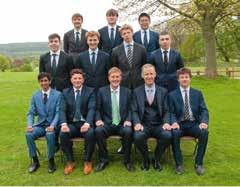
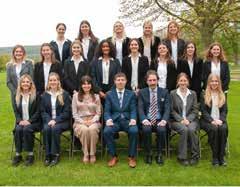
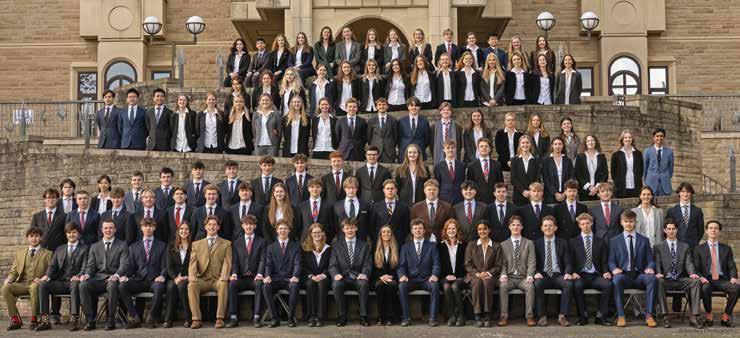
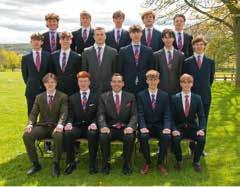
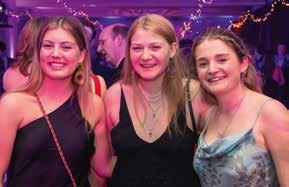
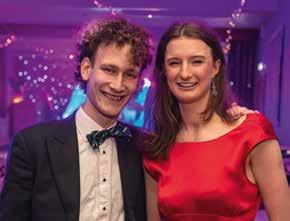
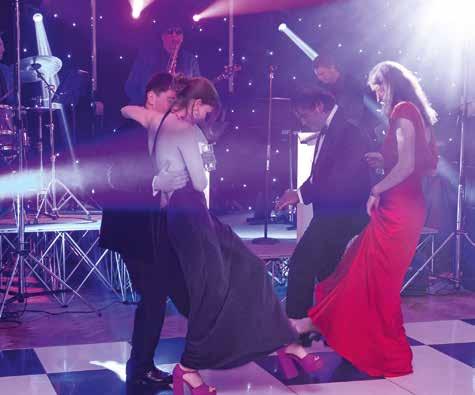
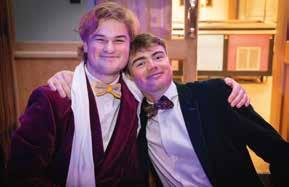



Another year of double leavers’ balls has just past. On the auspicious date of April 1 we held a leavers’ ball for the 2021 students and their parents (a COVIDcatchup event). Following the pattern of last year, everyone was invited back for a cheese and wine social on the Friday night. This served as a bit of an ice breaker for those who had not seen each other for nearly two years – everyone quickly picked up where they had left off, although there were a few exclamations of surprise as recognition dawned despite the new glasses/long hair/older and slightly wiser appearances. On Saturday afternoon Houses staffed by matrons and/or Houseparents welcomed parents and children for afternoon tea. Many enjoyed a trip down memory lane, looking around the House, and having time to properly catch up. With just time to go and get glad rags on, the ball kicked off with a champagne reception in the main hall followed by food, drink, and dancing in the refectory. A rather late night turned into an early morning for many with the numbers at the Abbey Mass significantly swelled by revellers. Many of this year group of OAs also came along to the OA cricket at Exhibition and I feel sure that they will continue to be a wonderful part of our community.
Following the success of last year’s leavers’ ball on the evening of Exhibition Saturday, we repeated this for the 2023 leavers. The event was held in the refectories this year with dining on the top floor and dancing and casino tables (!) on the lower floor. Delicious food, the amazing band and superb support from parents made the evening a huge success. Speeches from Charlie and Izzy in their capacity as Head Monitors hit just the right note. I have no doubt that we will welcome these soon to become OAs back to the valley many times in the future. They have been a wonderful Upper Sixth and we wish them all the best for the future.
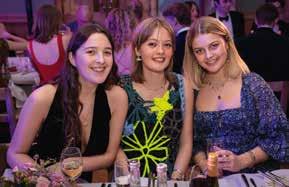
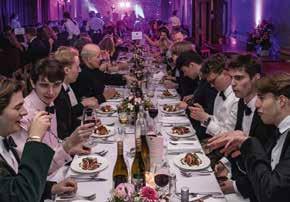
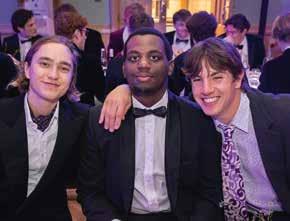



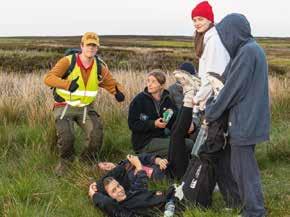
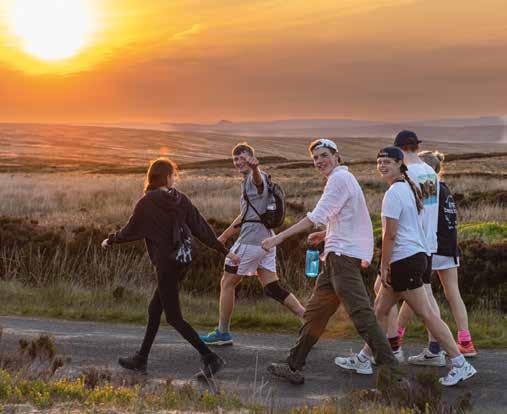 By Seamus Stainton (J) Year 12
By Seamus Stainton (J) Year 12
At midday on Saturday 10 June, 24 students, along with many members of staff, set off on foot from Whitby Abbey in unusually vibrant summer skies and hot weather – perfect for lazing on the beach, but daunting for our challenge. Ahead of us lay an 80km walk back home to school, to raise money for the Friendship Project and Oakfield School, a school for students with learning disabilities in Nottingham. After months of anticipation and training (and reminders to buy zinc oxide tape), we were equally nervous and excited. The first few hours went smoothly, strolling through Whitby and the surrounding countryside. We stopped for mass at St Hedda’s church in Egton Bridge. Fr Chad gave an inspiring talk, which he wittily called ‘The Big Talk’. After mass, you could hear “this is going to be easy” and “I can’t believe people made this sound so hard”. These phrases became less and less common as the sky became darker and darker.


Dinner was next on the agenda, and after feast of pasta bolognese served up by Mr Steele, we began the dreaded 5-hour night walk. Head torches were turned on and we put on extra hoodies and tracksuit bottoms. As the night set in the group began to rely on each other more, sharing music, food and laughs; anything to keep our minds off the 12 hours which lay ahead. Blisters became more severe, and some walkers had to move to the support vans due to injury.
After three hours of darkness, we were greeted by a beautiful sunrise, which Col Blackford showed us from a very scenic cliff top. The light brought its own challenges as tiredness began to affect everyone in varying degrees and the temperature began to rise quickly. The group pushed through and reached Helmsley around 8am. We were met by parents, family members and dogs, who after a big breakfast, joined us for the final leg. This was incredibly encouraging, and almost everyone completed the last leg to school with a spring in their step.
Fr Chad had told us St George’s flag would be raised to welcome us, and as promised, as we reached Ampleforth we saw the cross flying in the mid-summer blue sky above the Abbey. We were greeted by Bagpipes, friends, and teachers for the final stretch into school.
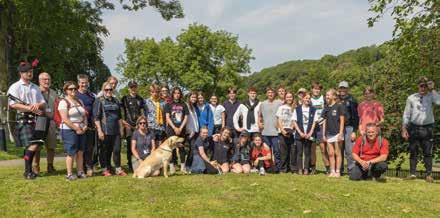
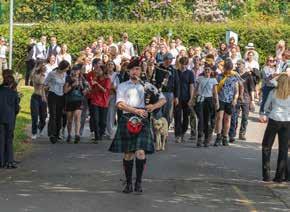
As we crossed the finish line, everyone was tired, everyone was hurting, but everyone was proud of themselves and proud of their friends, thankful that we were able to complete such a challenging 24 hours and grateful for the amazing support which enabled us to raise over £6,000 for Friendship Project and Oakfield School. It was an experience which we will never forget.
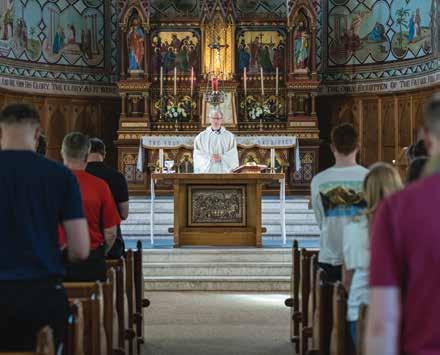
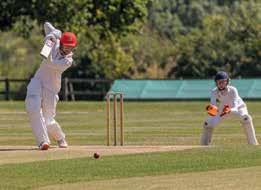
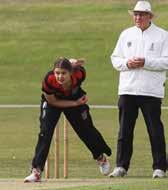
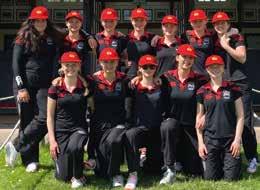

Girls’ cricket has really flourished in the valley this year. The talented U15 squad went one better than last year in the National Indoor Tournament, winning the North Yorkshire and Yorkshire Finals Days. At the North Finals, they finished joint third. Once they got outside in the Summer Term, there was little stopping them. They won the St Peter’s Tournament with an outstanding victory in the final against Sedbergh and were unbeaten in all other games. The Girls 1st XI also played some fine cricket. They were rarely bettered in the field and had an array of bowling options that stymied most opposition run chases. In total, there were six girls’ squads ranging from U18s to U12s with over 45 fixtures arranged. This bodes exceptionally well for the coming years.
The boys’ squads had a similarly busy schedule with 9 squads playing throughout the summer. Trying to emulate last year’s record-breaking 1st XI season was always going to be difficult, but the winter training programme and combined U14 & U15 boys and girls sports tour of Sri Lanka gave us an excellent head start when the summer term started. Although the pitch and overhead conditions were markedly different between Colombo and the valley, by the end of term, all teams had produced performances of note. The Boys 1st XI hosted the Emeriti Schools’ Festival welcoming teams from the UK and Australia and this, and the U13 Boys and Girls Worsley Cup (16 teams in total) were fitting ways to finish the year.

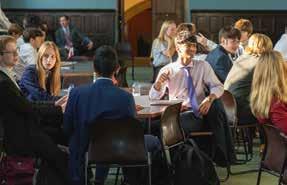

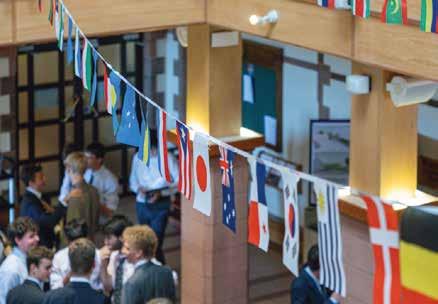 By Hannah Pomroy, Deputy Head
By Hannah Pomroy, Deputy Head
At the start of the year two eager students approached me to see if we could start a Model United Nations (MUN) Society. I knew absolutely nothing about this at all, except that it was ‘a good thing’, and so set about finding a member of staff who could help run one. Fast forward to the summer term and we (yes, including me!) have met weekly since November, attended a two-day conference at Shrewsbury School, helped train students from another school on MUN debate and process, and run our very own mini conference here at Ampleforth. The small group of two interested students has swelled to 15 regulars. We even have a tie and hoodies in production! In our weekly sessions each student plays the part of a different UN country, representing the views of that country on the resolution being debated; some choose countries they have an affiliation to, others pick countries with contrasting views. The strict protocol for the debates helps to shape the arguments and helps the students to explore views very different to those held personally. The students have debated topics as urgent and complex as women’s rights in Iran, peace between Russia and Ukraine, and a solution to the Palestinian/Israeli settlement issue. Best of all, the Society is entirely student-led and organised; a massive thank you to Niwa, Soraya, Johnny, Ed and Crispin for all their hard work and enthusiasm.
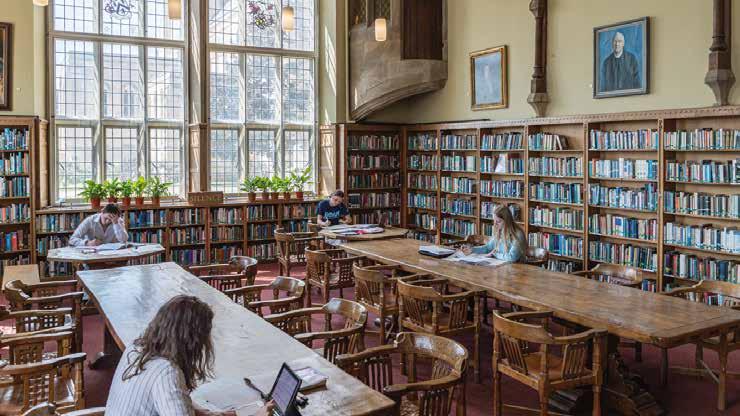
 By Denise Raine, Librarian
By Denise Raine, Librarian
Our college library embodies the living history of Ampleforth College, predating the current Abbey Church by a hundred years. Established as the school library in the second half of the nineteenth century, with significant expansions in the twentieth and some final touches early in the twenty-first, it grew with the school, room by room, and eventually took shape as the library that is greatly admired and much used today. We owe particular thanks to three previous Headmasters who each played a significant part in developing the library into such an impressive school resource.
With 50 pupils on the school register in 1858, the impressive new College building that opened in 1861 made ample library provision for older pupils in the upper library. The room was named for the upper school and is still reserved for Sixth Formers. For almost half a century, until the Theatre was constructed, a glorious view across the valley would have been enjoyed through the large south-facing window.
The magnificent Victorian architecture of the upper library has not changed but the arrival of some new furniture in 1921, “massive and antique in appearance”, was considered significant enough to be noted in the Ampleforth Journal. It was made of oak by a local craftsman, Robert Thompson of Kilburn, and included the weighty debating chair and a table reputed to weigh a ton and a half. Over a hundred years later, the furniture is still there.
Fr Paul Nevill became Headmaster in 1925. He was already acquainted with Thompson and his work and, with funding from the Ampleforth Society, employed him to fit out the adjacent room, (which had been the junior library), in oak. Thompson created individual study spaces called carrels along two sides of the room, each one made to measure and uniquely decorated with intricate high-quality carving. This was the beginning of the ‘Mouseman’ library as Thompson had adopted a trademark, now

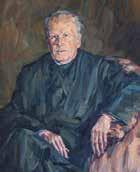
internationally known, which was a mouse discretely hand-carved on each piece of his handcrafted furniture. He said that the mouse symbolised his firm’s motto, ‘industry in quiet places’. How appropriate for the library!
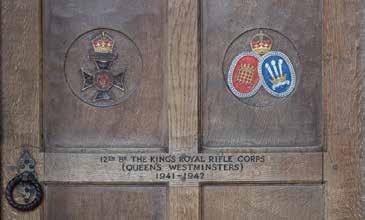
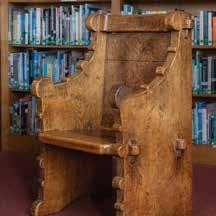

School numbers were 215 in 1926 and rising. Therefore, in 1934, the library carrels were extended into the next room, (previously a common room), making 22 in total. They are particularly interesting because of the heraldic shields carved in relief on the woodwork and splendidly painted in colour, each representing the coats of arms of a high-ranking Ampleforth family of the time. Some of these families are still represented in the student body and in study periods, in prep time, and most particularly at exam time, the carrels are greatly valued by students as silent study spaces.
Ampleforth played a crucial role in the career of Robert Thompson, establishing his reputation for high-quality craftsmanship using English oak. He is said to have loved Ampleforth and considered the library to be his best work; he fondly referred to it as ‘my room’. Sadly, Fr Paul, who had commissioned the Mouseman library, did not live to see the library door, Thompson’s final work for Ampleforth, installed in 1955.

However, Fr Paul had made a shrewd appointment of Fr Patrick Barry as School Librarian. Looking back years later, the impact Fr Patrick had was described in the Ampleforth Journal: “The young monk soon became a key figure in the life of the school. He taught Latin and Greek, and was appointed School Librarian: his love of learning and his very monastic sense that a library should be a place of order and of tranquil beauty had a profound and lasting influence on generations of boys. The only occasions in which speech was allowed in his library were during the popular weekly meetings of the school’s debating society, over which he presided with total fidelity to parliamentary procedures”. Fr Patrick was librarian for 22 years before he became Headmaster and then Abbot.

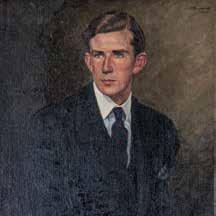
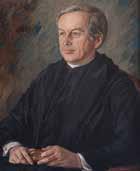

During his tenure the Ampleforth Journal notes a long loan of pictures from the collection of Lord Deramore of Heslington Hall, York: “The pictures of the greatest historical interest have been placed in the School Library and do much to increase the dignity of the room”. These splendidly framed portrait paintings still enhance the library.
Following the Second World War, the library expanded yet again into the next room along Big Passage. This is known as the memorial library to commemorate the 127 Amplefordians who lost their lives in the war. With money from the Old Boys’ Memorial Fund, Fr Paul commissioned Fr Patrick, who was skilled at lettering, to inscribe their names in stone. To complete the memorial, a crucifix was placed between the two stone tablets that are set high in the north wall of the library.
over the lower library, painted in oil on canvas by the award-winning portrait artist and OA, Brendan Kelly (D88). (Fr Leo had been Kelly’s Housemaster.)
Portraits of all the earlier Headmasters, including Fr Paul and Fr Patrick, hang in the upper library. Fr Patrick is also honoured by a bronze portrait bust, displayed in the memorial library under the crucifix. A large panel fixed onto the inside of the library door is dedicated to Fr Paul; composed by the classics master Walter Shewring, it bears a Latin inscription and was inscribed on vellum by OA John Martin (W48). Thus, the door itself honours the two men who brought the Mouseman library into being and made it such a special place for generations to come. Fr Paul, Fr Patrick, and Fr Leo undoubtedly significantly influenced the growth and development of the library to become the great asset that it is to the school today.
The following words by current students outline how the library provides a special place for them to focus and thrive in their studies at Ampleforth.
“The library, to me, means tranquility; I think this is best brought to mind by the beautiful interior, with its amazing versatility.”
One of the names on the war memorial is Hugh Dormer (A37), who was 25 years old when he was killed in action. He had written a diary whilst away at war and it was published in 1947. Hugh’s mother generously gifted the royalties made from the sale of the book to Ampleforth, and Fr Paul used this money to have new Mouseman shelving fitted around the upper library. A portrait of Dormer hangs there, in the part of the library that, as a Monitor, he would have had the advantage of using.
The final expansion was the addition of a lower library as part of the new central building scheme completed in 1988. It was used as a utilitarian workroom, where books were bound, but Fr Leo Chamberlain, then Headmaster, had the room beautifully refitted for the Ampleforth bicentenary in 2002, when it took shape as the comfortable and functional room we have today. Although the door had been the last work made by Robert Thompson himself for the library, it was not the last piece to come from his workshop in Kilburn, and Robert Thompson’s Craftsmen Ltd produced new bookshelves for the lower library bearing their registered trademark, the mouse. Appropriately situated there, an excellent portrait of Fr Leo looks
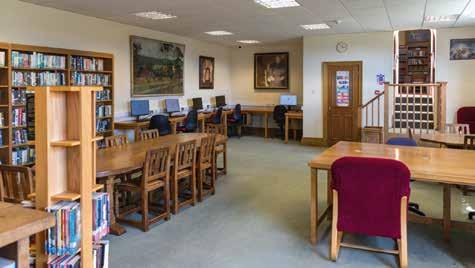
One student describes what the library means to her: “The library is one of the most useful features of the school. It is perfect in my free periods as it’s in the centre of school with such a nice and peaceful atmosphere. The carrels are perfect as they allow me to have an undisturbed place where I can fully focus on work I find challenging. The lower library is great because it’s a place for quiet discussion and it’s perfect for group projects or even just at times where I need help from someone.”
Alex Anakwe (A) Year 12Another student writes about how his perception of the library has changed over his year at Ampleforth: “When I first came to Ampleforth I didn’t pay much attention to the library. For me it was another boring room filled up with old books. However, as I started coming more often (for many different reasons) I noticed that the Ampleforth library is different from others. The interior decor as well as the library staff all create a unique, welcoming and supportive atmosphere. I suddenly realised how precious this space is and how many benefits it has. The library is a great place to do preps, revise with friends, read books peacefully or even sometimes socialise with others and I will forever cherish this place.” Tomasz

Matosek (C) Year 12
The final word is from someone who is currently sitting his exams: “The library, to me, means tranquility; I think this is best brought to mind by the beautiful interior, with its amazing versatility. With the individual carrels, which allow for independent study, but also the large Mouseman tables and chairs, enabling sociable group work. Along with the amazing staff, the library really nurtures my and other students’ learning.” Henry Scotho (J) Year 13

A couple of weeks ago, a group of Year 10 girls had the amazing opportunity to visit Stanbrook Abbey and Convent. We found out that converting to be a nun or a monk is not the only way in which you can strengthen your relationship with God. When we arrived, we saw something we didn’t expect which was a modern building made to be completely environmentally friendly. The truth is that looking after the planet and the environment is one of the best ways in which you can improve your religious life and feel closer to God as we as Christians have the duty to look after His kingdom.


This is something everyone can do a little something about because even if you think that you won’t make a change, you will, and unconsciously your relationship with God will be re-enforced as you will be helping look after the perfect world he created for us. Seeing all the efforts put in at Stanbrook Abbey to make it a 100% environmentally friendly place we realised that it is not impossible to play your part, and that it is a fantastic way to make sure you are fulfilling your Christian duties even if it is not only by praying all the time.
Rocio

This trip taught us all more about the life of a nun however, I am certain each of the girls who went on the trip went away grasping more clearly a different message about life.


What I first noticed in the Covent was all the nuns were very joyful and welcoming to their visitors. They wouldn’t give themselves the luxury of worrying about themselves too much and focused on shifting their attention towards other people or other duties they had to fulfil. I suppose in a way, depriving yourself from the privilege of analysing everything you feel is a gift because it allows you to experience things more simply, more beautifully. It allows you to accept things more graciously and deal with them more healthily.
Another thing I noticed was that the nuns recognised they wouldn’t always get along with each other, but they removed themselves from their pride. Rather they embraced themselves in humility and recognised that there were always two sides to a story. They admitted that not one single person is perfect, but they try to be the best versions of themselves every day.
As Christians, we believe we are all made in the image of God, and the nuns live by the simplest message of the Bible that we must see the good in everyone. I think that this deeper understanding and acceptance that it’s okay to get it wrong created a lot more trust within the Convent. The main thing I suppose I understood from this trip was to remove yourself from your prideful ego and to rejoice in humility, stop always thinking of yourselves and instead think of being and seeing the best in people.
I understand that sometimes it can be hard as I often find I think of myself too highly in moments of conflict in House, with a teacher, or with another student. We all hope, with God’s help, that we can turn ourselves away from selfish thoughts and towards a life of greater service. It is hard for us to be humble, but we hope that with the help of the Holy Spirit and holy church we can collaborate to be part of solutions to – and less the participants in – problems. Lastly, I would like to thank Mrs. Carter for organising this trip for us and I hugely recommend you all to sign up for it if the occasion arises again.
Victoria Collis (B) Year 10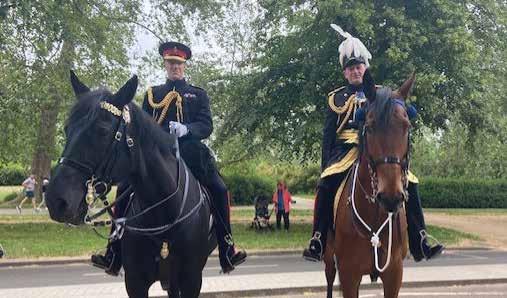
It is a certainty in a hereditary monarchy that coronation will follow funeral. And so, from September 2022, in the minds of all those working in the Army’s Headquarters in London, the spectre of the coronation was permanently on the horizon. It was self-evidently impossible to even consider this possibility during the funeral and its aftermath. It was not, therefore, until October 2022 that discussions started in earnest. Then, the guiding principles started to come thick and fast: “magnificent, but not ostentatious” and the requirement to build the spectacular through the day were early guidelines. We set to work to design a series of parades that would meet these stipulations and be acceptable to stakeholders. Unlike many ceremonial events, there is no template or agreed custom around a coronation. So, while we thumbed the well-worn pages of the 1953 plan, there was no binding requirement on us to abide by what had taken place 70 years before.
Looking back, it was an unforgettable day in the history of the country and unique
in a number of ways. First, in a way that would have been wholly familiar to our predecessors in 1953, all the military personnel involved in the coronation entered and departed London by train from their concentration areas across southern England. Network Rail delivered a stunning performance by laying on special trains for the first time in a generation. This meant later starts for those involved in moving from the concentration areas but, from the perspective of the Metropolitan Police, removed the requirement to park over 150 coaches on 1.8 miles of secured London streets.
The command structure for the entire operation was set early and wisely with the appointment of the Department for Culture, Media and Sport (DCMS) as the lead government department. The wellrehearsed and very capable team in the Department led the other agencies capably and professionally through the preparation phases. Given the complexity of the environment, a step-change from 1953, this was vital, and we were happy and content subordinates to the DCMS planners
who were excellent in providing for the detail of the ceremonial to take place. Similarly, we forged early and very strong relations with the officers responsible for commanding the police operation. I walked the Mall the day before the event, and met police officers from Wales, Bedford and Hertfordshire: a clear sign of the importance and effort the service countrywide attached to the event. The relationship became even more important as credible reports of attempts to disrupt the procession emerged, which the police dealt with appropriately and professionally.
The scale of the 1953 parade was significant; just under 30,000 military personnel took part. Clearly, the world has changed somewhat in the intervening 70 years, and so we knew that our contribution would be numerically far smaller this time. We worked out, however, that the number on parade was proportionally about the same as had paraded in 1953. Some things, however, remained unchanged: descriptions of contingents flying from far-flung parts of the world remained the same as 1st Battalion Coldstream Guards were
recovered from an exercise in Kenya and re-deployed onto the square at almost the last safe moment at the end of April with no discernible reduction in the quality of their drill.
One issue dominated the early planning conferences: how would the parade conclude? Options were discussed: the ‘Hyde Park Corner’ moment following The Late Queen’s funeral had been iconic: could there be a similar parade at Hyde Park Corner? Might The King mount a dais and take a march-past as He does following Trooping the Colour? Should we all simply march back to barracks –surely something of a let-down? From

these discussions came the idea of a review and final royal salute in the garden of Buckingham Palace. Consent was secured from the Royal Household, and so detailed planning for the ‘garden moment’ began. At the conclusion of the parade, it allowed the contingents who had put so much hard work into the delivery of the spectacular to see The King and deliver a personal tribute. This was especially important to those who had come from the Commonwealth for the day. From the perspective of all those who took part and watched the event, there is no doubt that the ‘garden moment’ was a stroke of genius and was memorable equally for King and subjects.
From an Ampleforth perspective, we were once again well represented. The Duke of Norfolk (T74), fresh from his organisational triumph at The Late Queen’s funeral, once again led the planning for the event. Colonel Mark Berry (T94) rode directly behind the Gold State Coach as Silver Stick in Waiting and numerous Old Boys were involved in the procession back from Westminster Abbey. For all those who took part, however, it was a chance to pay tribute to our newly crowned monarch, and that was an opportunity which will live long in the memory. Last, as in 1953, it rained, but given the spectacle, and the concentration on the task in hand, I am not sure we really noticed. God Save The King!
Postscript:
Other OA involvement in Westminster Abbey on the day included Xavier Leitch (J21), who was one of the taperers, so one of the tiny number who actually witnessed the anointing of King Charles as he was positioned very close to the altar during the service, and Alex Hopkins (D16), who, as one of our former Music Scholars and a highly valued member of Schola, we were delighted to see singing in the choir.
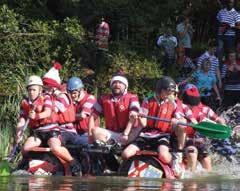
My library of memories is full of titles including St Oswald’s, St John’s, St Martin’s, St Edward’s and St Wifrid’s – a veritable litany of editions. Opening St John’s at the ‘Contents’ page is interesting. I am not going to read to you the chapter ‘Harry’s Year of Chemotherapy’ or the section ‘Rowathons and Rafts,’ or the chapter (stained with drops of something red and wine-like) entitled ‘Understanding the Finer Points of Wine Tasting.’ Looking at the ‘Index’, there is a long list of details and dates, and near the top of the index ‘Benediction and Exposition’, with the sub-headings
‘Fr Adrian’, ‘Fr Cyprian’ and ‘Br Ambrose’.
novel The Shooting Party. I have taken the greatest delight, though, in teaching my subject in the classroom. From the Greek myths to Milton’s Paradise Lost, and on to contemporary poetry I seem to have covered in my teaching, one way or another, the whole history of English Literature and its western metanarratives. (To you and me that means the Greek myths and The Bible.)
Literary Reflections: do better
Since coming to Ampleforth in 2005 I have continued to read and study medieval literature. My doctorate is on the animal in medieval literature, and the philosophy and theology behind our attitude to
perhaps both. It is also an inquiry into the nature of knowledge, especially in its final chapters. Shepherd herself called it a “traffic of love” with the mountains, and that word “traffic” implies for her the idea of “exchange.” It is because of that comment that I think its genre is that of a love story. It is unusual in that most works of mountain literature are written by men, and most male mountaineers are focused on the goal of the summit. Shepherd, though, wanders into the Cairngorms “merely to be with the mountain as one visits a friend…I am on the plateau again, having gone round it like a dog in circles to see if it is a good place…I think it is, and I am to stay up here
These chapters are fragrant still, from charcoal and incense.


I have adored my time (18 years!) at Ampleforth. I found it hard work, but I cherish(ed) in particular my time and my memories of being the Housemaster of St John’s, and I am still in touch with many of the young men who I had the privilege of supporting and enabling throughout their senior school years. I learned to play the pipes when in St John’s – there were so many pipers at one time that I felt I had to! Having played trumpet with the Orchestra and Big Band, I could not as Housemaster get the time away from the House, so the pipes became my new musical toy. I ran a very regular wine society, and the sixth form of the House prided themselves on some good understanding of grape varieties and their ability to match particular wines with the ‘right’ foods. Impressed with the Sixth Form discussion groups, Years 9, 10 and 11 all asked for one … so at one time we met to talk current events, Philosophy and Theology, five nights a week! There were book clubs too: the year I ran one on St Oswald’s culminated in a very full study, and a firm following of the


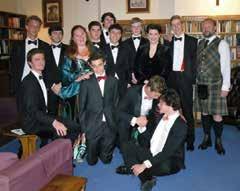

animal natures – including our own. I have continued to publish articles and reviews and have occasionally been asked to advise on books academics were writing – a great privilege. I would never have thought at age 18 that books would be in my future, let alone the better part of it, but they have become so.
My time at St Martin’s Ampleforth resulted in lots of talks, book clubs and library sessions, not least of all on the topic of the re-wilding of our language and reconnecting with our environment through words and books – in fact knowing the names for things. The castle’s environs along with its huge library seemed ripe for such exploration. Two books that stand out as ‘hits’ (I even bought copies for parents) are Nan Shepherd’s short The Living Mountain, and W H Murray’s Mountaineering in Scotland and Undiscovered Scotland
The Living Mountain is difficult to describe, but it is worth doing, I think, if for no other reason that as I go off into the hills it seems my most apt valedictory comment. It is rather like a celebration in the form of a prose-poem, or perhaps a quest, or
W H Murray’s spiritual thinking was one of reverence for and celebration of wild places, not in the sense where man is dominant or even a steward of the earth, but as ecocentric; the earth does not belong to man: man belongs to the earth. In his work he uses a phrase after a sub-zero but very special night spent outdoors in Glencoe, and which later became the title of his biography. He says that in the mountains we may find the “evidence of the things not seen” – the spiritual dimensions of our world which are at first sight taken for granted or beyond our ken. As Shepherd, he links his experience of Nature with the notion that there is something important that it signifies, and which is in some way embodied in the landscape.
sunlit summit, he says: “{w}isdom standeth at the top of high places. From our promontory we look up to the cloud of unknowing that wraps the last height, and from its radiance we know the summit is in sunlight.” (Mountaineering in Scotland)
The End of the (fishing) Line: Do Best
This chapter is stained with mud from the shores of the water courses in our valley.
The self-imposed rules that Nairac kept are, Jennings claims, good rules for life. You might say this is about the notion that: I could do what I want, but I should do what is right. Moreover, I should be able to take pleasure from and pride in watching myself do something the right way Jennings tells us:
By Dr David Mosesfor a while.” I love this description because it is not about rushing, or ticking-off a list, but about fully experiencing. It is for me a metaphor for educational enrichment.
Does it fit comfortably with Ampleforth’s core values? Absolutely, with the notions of respect, stewardship, and in particular with that thing, integrity. Nan Shepherd understood that, like reading, going out into the mountains is really about going into one’s self. Finding the self, we become the intense perceiver of our own actions, and as witness to them, closer to God.
Finding the path through the mountains is surely also about finding a path through language and literature. Shepherd’s poetic description of the living Cairngorms is compulsive and cultivates a wonderful vocabulary, the likes of which I have always encouraged students to make their own. In the process it is good if not excellent to take up advocacy for the mountains and wild places and countryside, and to hail the rejuvenating power of our environments. At St Martin’s, for a while, we worked hard at that, and at naming as much around us in our little Eden as we could.
Such writers have developed their ability to express their world, to gather a vocabulary which takes them beyond mere description to the life going on within, or even beyond a place. Murray suggested quite explicitly why ‘connection’ with the land is so important: “We might remember that despite our almost overwhelming technology, we are still flesh and bone” and thus a part of our environment. His experiences in the mountains often come across as holy ones, as though he has separated from his former self to become someone refreshed.
Our sense of place, in the same way, is integral to our life in ‘the valley’, and our landscape important as an arbiter of meaning in our spiritual journey.
Murray tried his vocation as a Benedictine monk in the period before his horrific experiences between 1939 and 1945. The monastery was not for him; instead he found the cathedral of the mountains his spiritual home. His search for mystical meaning became bound inextricably with his devotion to the mountains and wild landscapes. They helped him to discover realms of his own life that he was previously unaware of. He felt mountains enabled him to go beyond the limits of his own human-centred thinking. He could not take the sacred out of wildness. Using biblical and mystical language, and his perennial metaphor of the
This is a lovely chapter. It is read often and flows often through my memory. It is of the day when I took two Year 10 students away from the valley to a spot where we could fish for a few hours and perhaps catch something to eat. The mother of one of the students had told me how he had been fishing a local river, with the beautiful tackle inherited from his grandfather, for many years. We arrived at the lakes and started to cast. His first catch on that day was a 2lb rainbow trout. He was thrilled, and then went on to catch a 4lb trout which we later hot-smoked and shared with the House. I sent a picture of him with beaming smile and holding the trout to his mum, and she immediately ‘phoned me. “He is delighted, so happy … to have caught that fish.” I was puzzled and said “but he has been fishing for years.” Pause on ‘phone. “Yes” she said, “but he has never actually caught anything before!”
A river runs through my memory; but the little river which runs through our little valley no longer has its fish and is populated now only by the happy memories of them – and by some trout shaped holes in the water where the fish once lived. Toward the end of his book Blood Knots Old Amplefordian Luke Jennings (E71) reflects on the way that his friend, Old Amplefordian Robert Nairac (E66), chose to fish when fly-fishing for trout and grayling here in our valley. This was not just to cast any old bait or fly but to follow a very ‘purist’ method of casting imitation dry flies ‘up-stream.’ That is the hard way, but other methods were seen as ‘dishonourable’ because they tricked the trout into taking bait which it could not resist, rather than imitating nature and thus meeting the trout on its terms.
“I understand now why Robert was absolutist in his method, and why he spoke of honour and the dry fly in the same sentence. Because the rules we impose on ourselves are everything – especially in the face of nature, which for all its outward poetry, is a slaughterhouse. It’s not a question of wilfully making things harder, but of a purity of approach without which success has no meaning. And this, ultimately, was his lesson: that the fiercest joy is to be a spectator of your own conduct and find no cause for complaint.”
Integrity again. It is not always important to have witnesses to our actions, but it is important that you know that you are doing, or at least are trying to do things, properly. As William of Langland structures the progression of his eponymous hero’s spiritual progress in that epic medieval poem Piers Plowman: do well, do better, do best. And as Jennings observes, success is often about meeting the standards we know are hard for us, but which we set for ourselves and then strive to meet. Setting high standards of attainment in all things has with it a great joy – that of watching yourself meet those standards and not letting yourself down. It is not that others know: it is that you know.
I have preached this. It is not about me. But I hope that, in some way, I have lived up to it too.
Pen down now, and I close this book. This final chapter is finished. Tomorrow I will start to write a new book. My library is far from complete
Dr David MosesSigning off from Ampleforth March 2023
“Setting high standards of attainment in all things has with it a great joy – that of watching yourself meet those standards and not letting yourself down. It is not that others know: it is that you know.”
